Timor-Leste is home to a diverse range of unique and fascinating bird species, ranging from endemic species to migratory species that travel to Timor-Leste from around the world.
The country boasts an impressive collection of over 200 species of birds, making it a must-visit destination for birdwatchers and nature enthusiasts. From colorful parrots to exotic raptors, Timor-Leste has a variety of avian life that is sure to delight any bird enthusiast.
This article will provide an overview of the most noteworthy birds of Timor-Leste, highlighting their habitats, behaviors, and conservation status.
1. Australian Pratincole
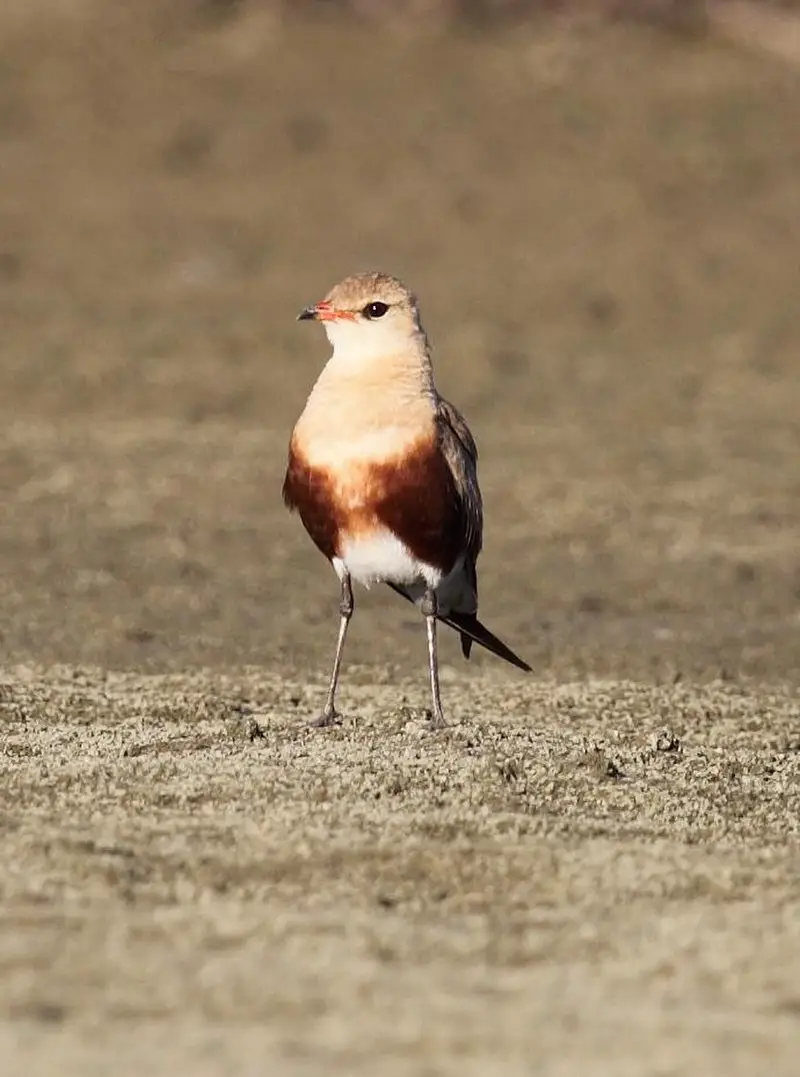
The Australian Pratincole is a species of bird belonging to the Glareolidae family. It inhabits Australia’s interior, with winter migrations extending into northern and eastern parts of the continent, Indonesia and New Guinea.
This medium-sized shorebird can be found in arid regions across central Australia where it breeds. Its range extends from south-western Queensland through to northern Victoria.
They have an elegant appearance due to their long wings and legs which make them well adapted for living on open plains and grasslands as they hunt insects using its unique aerial swooping technique.
The diet also consists primarily of beetles, flies, crickets etc., along with some seeds when available during dry periods or droughts in certain areas within their habitat range.
These birds are known for their social behaviour; often seen forming large flocks that can number up to thousands.Scientific classification:
| Kingdom | Animalia |
| Phylum | Chordata |
| Class | Aves |
| Order | Charadriiformes |
| Family | Glareolidae |
| Genus | Stiltia G.R. Gray, 1855 |
| Species | S. isabella |
2. Orange-Footed Scrubfowl

The Orange-footed Scrubfowl is a small Megapode of the family Megapodiidae found in several islands from Lesser Sunda Islands to southern New Guinea and northern Australia.
It has a dark brown coloration with bright orange legs and feet that stand out against its body, making it quite an eye-catching species.
The bird’s size is roughly equal to that of a domestic chicken.
This species feeds mainly on insects, fruits, seeds and roots but will also scavenge for carrion or feed on worms when available.
They are typically solitary birds except during breeding season when they tend to form colonies near their nesting sites usually along beaches or sand dunes where they can use the heat generated by the sun reflecting off the sand in order to incubate their eggs without having build nests themselves.
Overall this unique bird stands apart from other members of its family due to its striking plumage as well as being one of few ground dwelling megapodes instead of tree dwellers like most others within this group which makes them relatively easy to spot among greenery if you know what you’re looking for.Scientific classification:
| Kingdom | Animalia |
| Phylum | Chordata |
| Class | Aves |
| Order | Galliformes |
| Family | Megapodiidae |
| Genus | Megapodius |
| Species | M. reinwardt |
3. Lesser Coucal
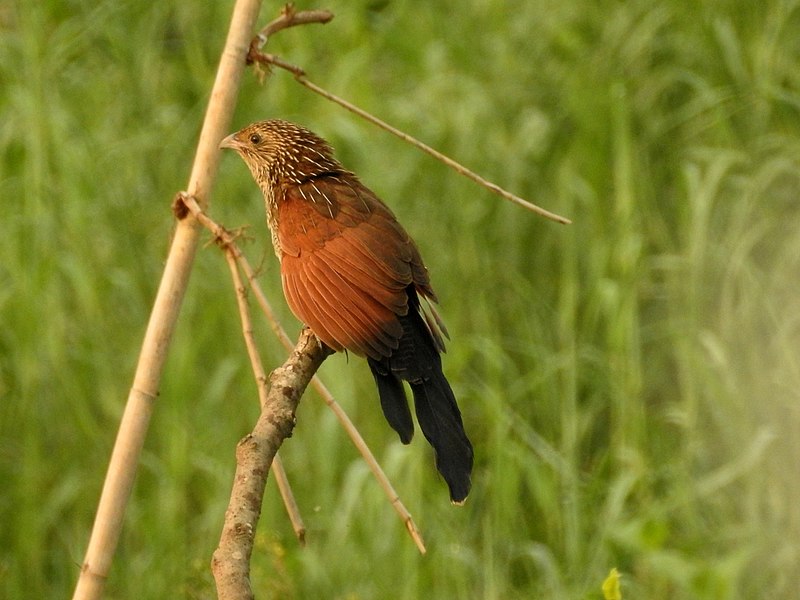
The Lesser Coucal is an iconic bird of the Cuculidae family. It has a wide distribution range and can be found in wetland habitats with plenty of grass, trees and shrubs.
This species stands out due to its relatively small size compared to other cuckoos as well as their less prominent bills and pale shaft streaks on the feathers of their heads and backs.
They have long claws which they use for perching or catching prey while hunting, making them efficient predators.
The calls made by these birds are quite distinct from those heard from other members of this genus – it sounds like two stones being knocked together.
All in all, this unique species is truly fascinating.Scientific classification:
| Kingdom | Animalia |
| Phylum | Chordata |
| Class | Aves |
| Order | Cuculiformes |
| Family | Cuculidae |
| Genus | Centropus |
| Species | C. bengalensis |
4. Timor Green Pigeon
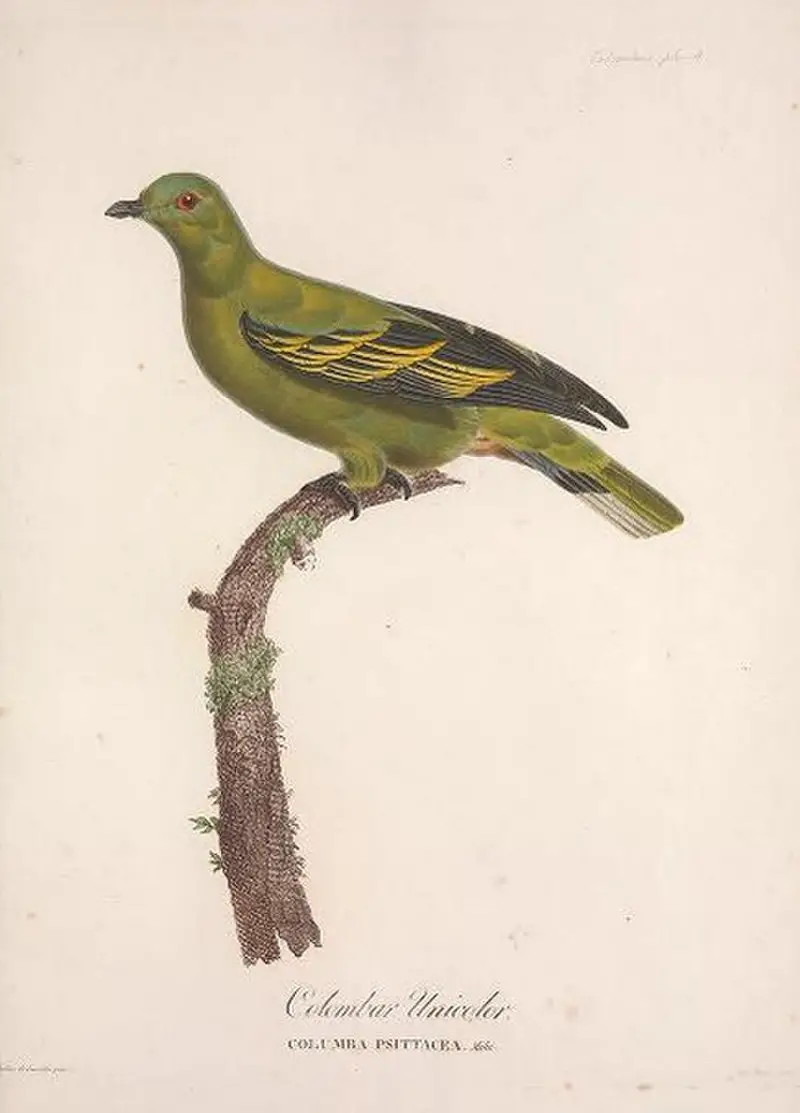
The Timor green pigeon is a species of bird found in the family Columbidae. It can be seen on the islands of Rote, Timor, Semau and Atauro in the Lesser Sundas.
This beautiful creature inhabits primary forest as well as monsoon forests and secondary growth vegetation areas near these forests.
Unfortunately this species is threatened due to habitat loss caused by human interference like deforestation for farming or timber trade activities.
The population has declined significantly over recent decades so it’s important that efforts are taken to protect their natural habitats and ensure their survival into future generations.Scientific classification:
| Kingdom | Animalia |
| Phylum | Chordata |
| Class | Aves |
| Order | Columbiformes |
| Family | Columbidae |
| Genus | Treron |
| Species | T. psittaceus |
5. Timor Imperial Pigeon
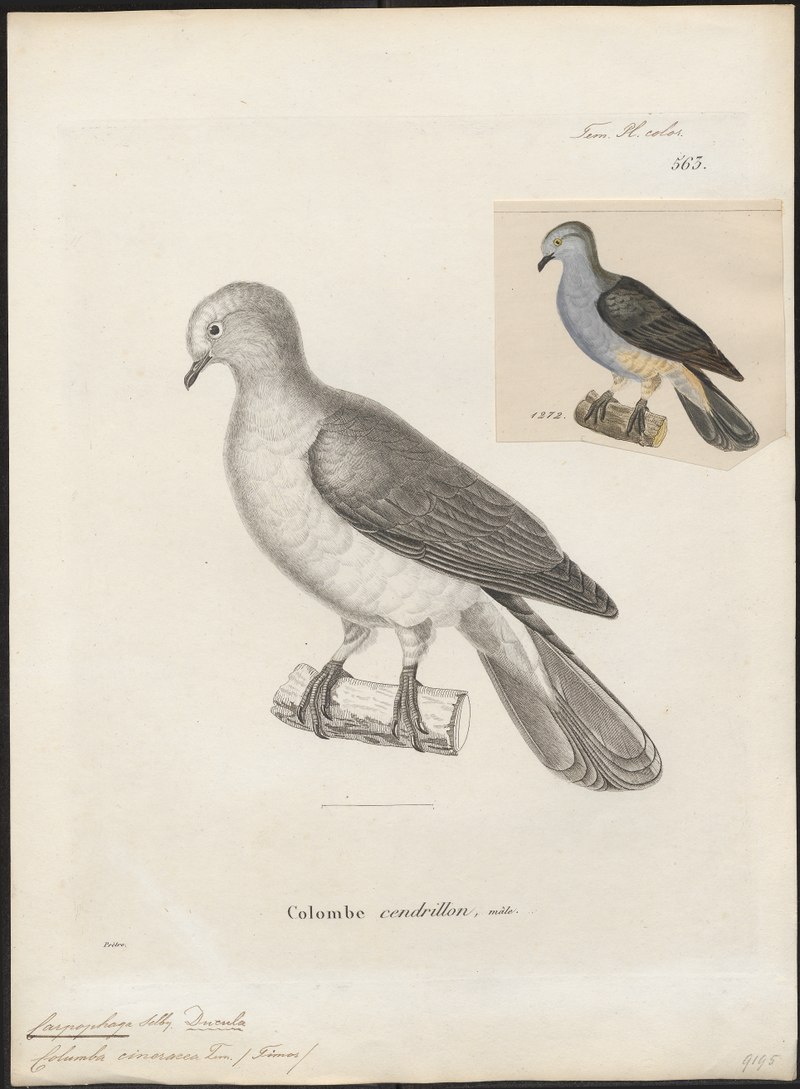
The Timor imperial pigeon is an impressive bird species in the family Columbidae. It inhabits both subtropical and tropical dry forests as well as montane forests in Wetar and Timor islands.
Unfortunately, this majestic creature’s natural habitat has been threatened by deforestation which makes it vulnerable to extinction.
The bird features a unique grey body with black barring on its wings, chestnut head and neck feathers as well as a yellow bill tipped with red colouring at times.
Its feet are also coloured bright pink. The birds feed mainly on fruits such as figs but will occasionally eat insects too for added protein intake during reproduction season or when food sources become scarce due to seasonal changes or other factors affecting their environment negatively.
Therefore we should strive to protect these beautiful creatures from extinction through conservation efforts such planting more trees around the area where they live so that future generations can continue to enjoy them for many years come.Scientific classification:
| Kingdom | Animalia |
| Phylum | Chordata |
| Class | Aves |
| Order | Columbiformes |
| Family | Columbidae |
| Genus | Ducula |
| Species | D. cineracea |
Also Featured In: Wetar Island Birds You Need to Know,
6. Pink-Headed Imperial Pigeon
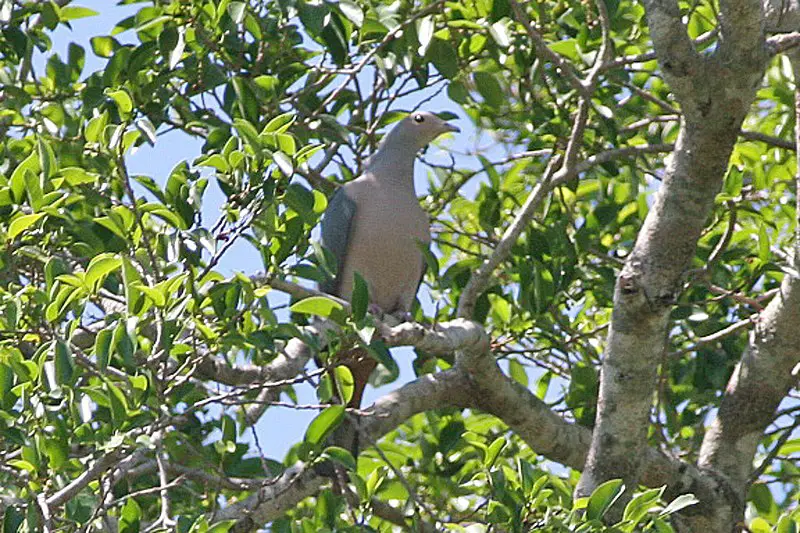
The pink-headed imperial pigeon is a species of bird native to the Lesser Sunda Islands in Indonesia. It inhabits subtropical or tropical moist forests, mangrove forests and shrublands.
This majestic creature has an unmistakable reddish head and wings that are light grey with black markings.
Sadly, its population faces a decline due to habitat loss so it is currently listed as threatened on the IUCN Red List.
Conservation efforts must be taken now if we want this beautiful species to survive for many generations more.Scientific classification:
| Kingdom | Animalia |
| Phylum | Chordata |
| Class | Aves |
| Order | Columbiformes |
| Family | Columbidae |
| Genus | Ducula |
| Species | D. rosacea |
7. Cinnamon-Banded Kingfisher
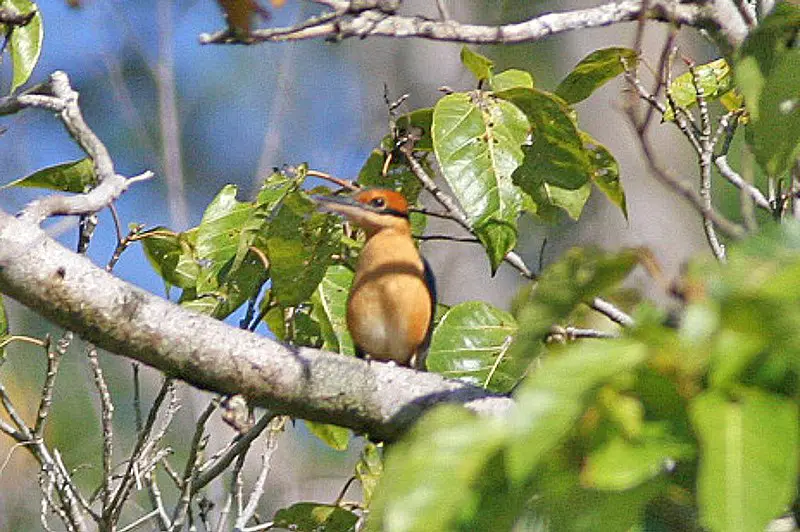
The Cinnamon-banded Kingfisher is a stunning species of bird found in Indonesia and East Timor.
Endemic to the Lesser Sundas, this beautiful creature has an easily recognizable bright cinnamon-colored band across its chest.
It makes its home in subtropical or tropical dry forests but unfortunately these habitats are facing destruction due to human encroachment and development which is putting the future of this species at risk.
The Cinnamon-banded Kingfisher relies on well maintained ecosystems for food, shelter and safety so it’s important that we do what we can to protect them before they become extinct.Scientific classification:
| Kingdom | Animalia |
| Phylum | Chordata |
| Class | Aves |
| Order | Coraciiformes |
| Family | Alcedinidae |
| Subfamily | Halcyoninae |
| Genus | Todiramphus |
| Species | T. australasia |
Also Featured In: Birds in Sumba,
8. Wetar Ground Dove
The Wetar ground dove is a species of bird found in Indonesia on the islands of Wetar and Timor. Its habitat includes monsoon forests, gallery forests, woodland, and bamboos.
Unfortunately this species is endangered due to threats such as hunting and loss of its natural habitats.
First described by Hermann Schlegel in 1871 from Weta as “Leptoptila hoedtii,” it has been assessed as an endangered species according to the IUCN Red List since 2000.
The wetar ground dove typically nests on bare soil or among rocks where vegetation is scarce; their diet consists mainly of seeds obtained from grasses near water sources.
As part of conservation efforts for this beautiful bird, we must work towards preserving existing areas that contain suitable habitats for them so they may continue to thrive.Scientific classification:
| Kingdom | Animalia |
| Phylum | Chordata |
| Class | Aves |
| Order | Columbiformes |
| Family | Columbidae |
| Genus | Pampusana |
| Species | P. hoedtii |
9. Black-Banded Flycatcher
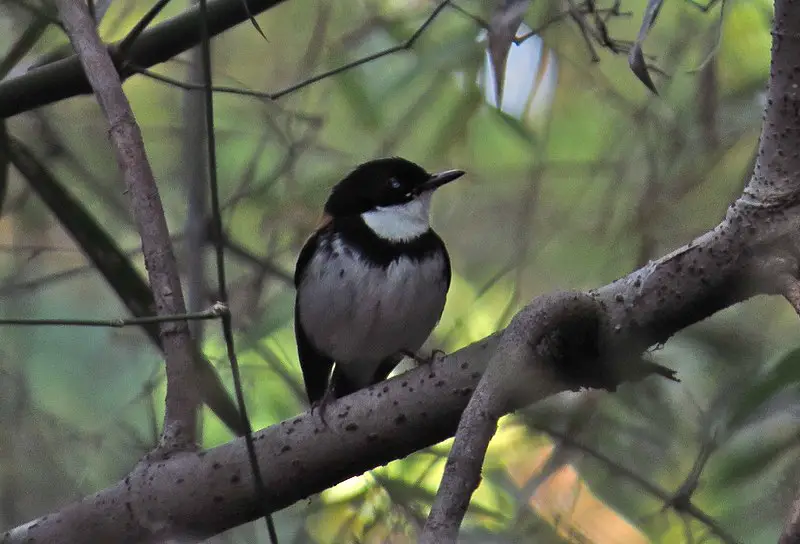
The Black-banded Flycatcher is a small bird found only on the island of Timor. It has an impressive plumage, with black wings and tail feathers contrasted by white underparts and head.
Its bill is broad in shape which helps it to feed upon insects that inhabit its habitat.
The species was once thought to be related to Australasian robins but this assumption was due to convergent evolution; the two birds have adapted similar traits despite being unrelated.
Despite their beauty, these birds are still classified as vulnerable due their limited range and human activities such as deforestation which threaten them greatly.Scientific classification:
| Kingdom | Animalia |
| Phylum | Chordata |
| Class | Aves |
| Order | Passeriformes |
| Family | Muscicapidae |
| Genus | Ficedula |
| Species | F. timorensis |
10. Metallic Pigeon
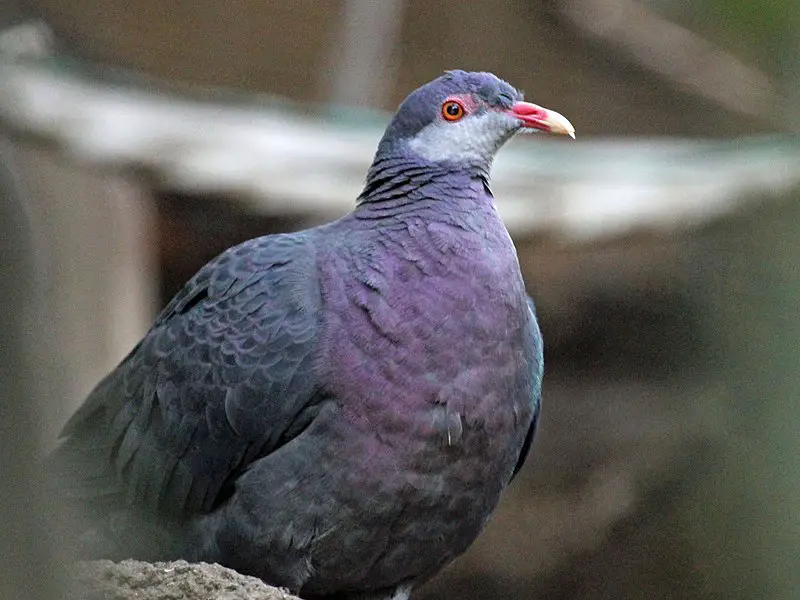
The Metallic Pigeon, or white-throated pigeon, is a medium-sized bird of the family Columbidae. Measuring up to 37 cm in length, it boasts an array of beautiful colors and features.
It has a dazzling iridescent purple and green crown, black wing and uppertail coverts with yellowish red eyes surrounded by red orbital skin around each eye.
Its beak is yellow while its chin and ears are covered with either grey or white feathers.
The underbelly shines brightly in chestnut or glossed purple shades for added beauty when flying about its natural habitat.
Lastly, this spectacular species sports purplish feet which act as perfect complements to their already colorful plumage.Scientific classification:
| Kingdom | Animalia |
| Phylum | Chordata |
| Class | Aves |
| Order | Columbiformes |
| Family | Columbidae |
| Genus | Columba |
| Species | C. vitiensis |
Also Featured In: Birds of New Caledonia, Common Birds of Lombok
11. Little Cuckoo-Dove
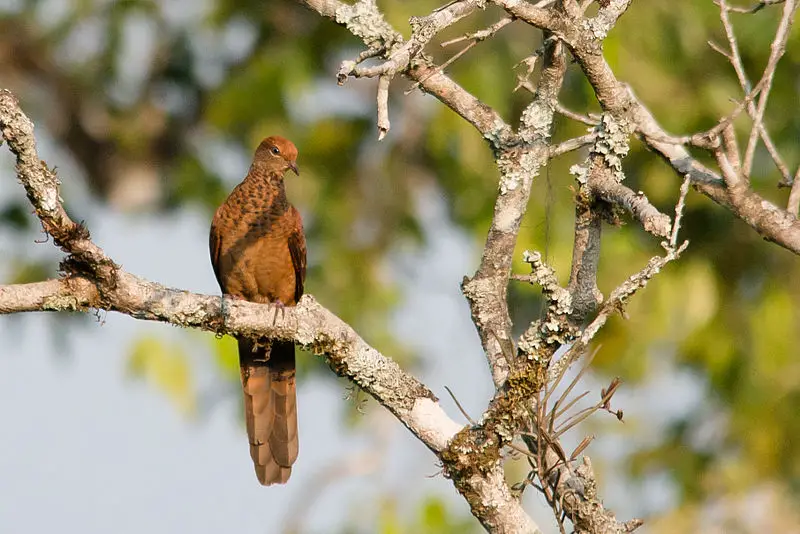
The Little Cuckoo-Dove is a species of bird found in many parts of Southeast Asia. It has reddish brown plumage, and measures up to 28 cm (11 inches) long.
It feeds mainly on fruits, seeds and buds from trees or shrubs. This bird is rated as being of least concern by the International Union for Conservation of Nature Red List due to its wide distribution range and stable population trend throughout its habitat range.
Despite this, it still faces threats such as deforestation which can degrade their habitats leading to reduced food resources available for them.
Therefore preserving these birds’ natural habitats should be considered an important conservation priority so that we may continue to enjoy the beauty they bring into our lives.Scientific classification:
| Kingdom | Animalia |
| Phylum | Chordata |
| Class | Aves |
| Order | Columbiformes |
| Family | Columbidae |
| Genus | Macropygia |
| Species | M. ruficeps |
Also Featured In: Most Common Birds of Ko Samui,
12. Red-Capped Plover
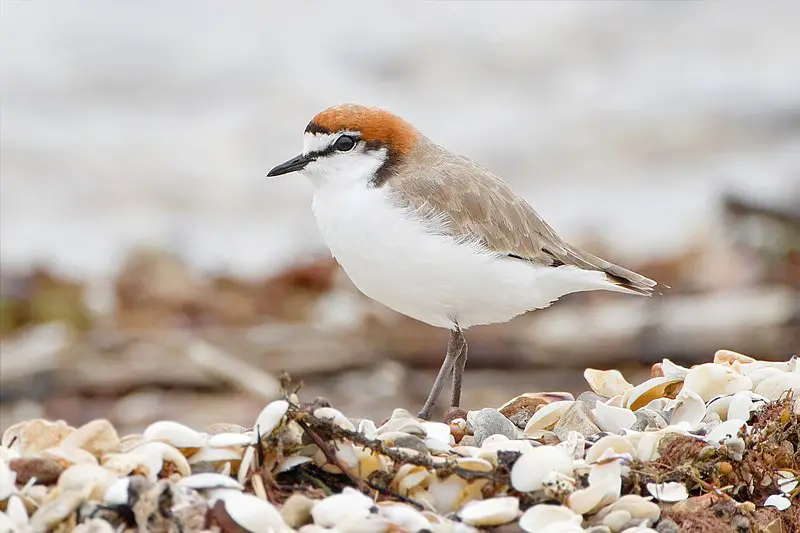
The Red-capped Plover, also known as the Red-capped Dotterel, is a small species of plover that breeds in Australia. It has a white forehead and underparts with grey-brown upperparts.
Adult males have a rust red crown on their heads while females lack this feature but still have some brown coloration across the nape of their necks.
The wings are blackish with bright yellow margins while they possess faint streaks underneath them.
Their long legs are grey or greenish in color and they usually run rather than fly when flushed from cover.
They feed mainly on insects which they hunt by wading through shallow water or probing soft mudflats for food items like worms and crustaceans.Scientific classification:
| Kingdom | Animalia |
| Phylum | Chordata |
| Class | Aves |
| Order | Charadriiformes |
| Family | Charadriidae |
| Genus | Charadrius |
| Species | C. ruficapillus |
Also Featured In: South Australian Birds, Common Townsville Birds
13. Rose-Crowned Fruit Dove
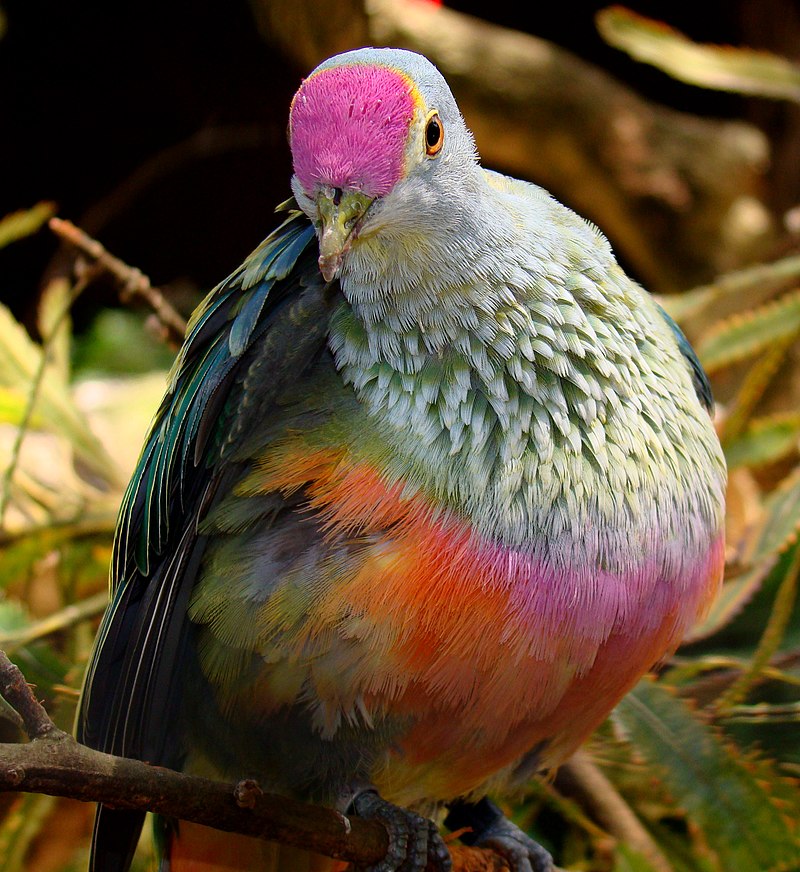
The Rose-crowned Fruit Dove is a beautiful and vibrant bird found mainly in the forests of Australia, New Guinea and some parts of Indonesia.
It has an unmistakable appearance due to its grey head and breast, orange belly, whitish throat and yellow-orange iris.
The crown on its head is pinkish-red with a yellow border which sets it apart from other fruit doves. This species can grow up to 22 cm long and have greyish green bills as well as feet.
In Indonesian subspecies however have white crowns instead of red ones.
They are generally found in small groups feeding on fruits or berries near trees or shrubs but they may also be seen alone occasionally when searching for food during the day timeScientific classification:
| Kingdom | Animalia |
| Phylum | Chordata |
| Class | Aves |
| Order | Columbiformes |
| Family | Columbidae |
| Genus | Ptilinopus |
| Species | P. regina |
14. Barred Dove
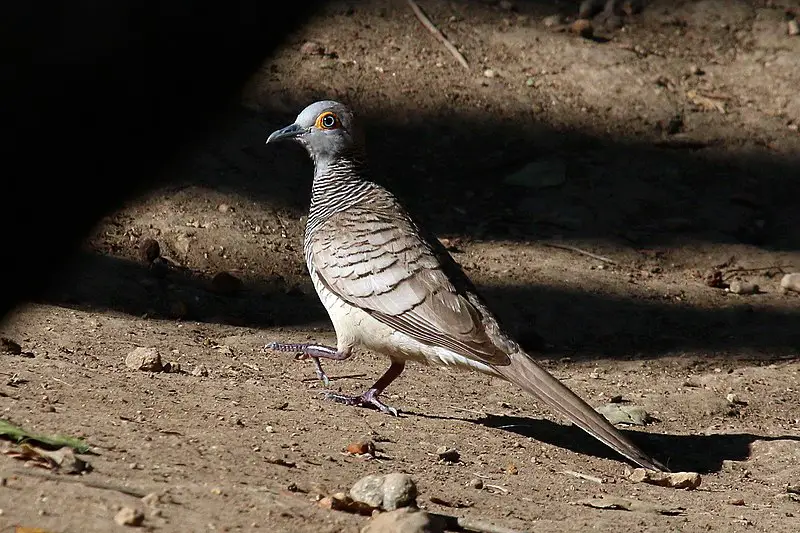
The Barred Dove is a small species of dove found in the Lesser Sunda Islands of Indonesia. It has distinctive black and white barring along its body and wings, giving it an easily identifiable appearance.
This bird inhabits open woodlands, scrubland and cultivated areas at low elevations such as Sumbawa, Flores, Sumba, Timor or Tanimbar Islands.
They are closely related to zebra doves from Southeast Asia and peaceful doves from Australia & New Guinea.
These birds feed on seeds & insects which they forage for on the ground. Breeding takes place between April-June when two eggs are laid in shallow cup nests made out of twigs lined with grasses or hair gathered by both parents.
The male courtship display involves bowing with tail fanned spread wide while cooing softly to attract a mate during nesting season.Scientific classification:
| Kingdom | Animalia |
| Phylum | Chordata |
| Class | Aves |
| Order | Columbiformes |
| Family | Columbidae |
| Genus | Geopelia |
| Species | G. maugeus |
15. Pittas
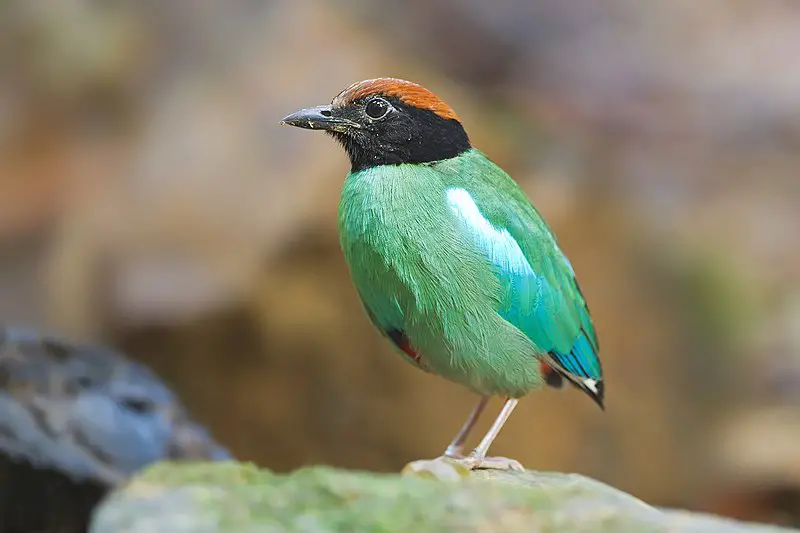
Pittas are a family of passerine birds known for their vibrant colors and unique appearance. They can be found in Asia, Australasia and Africa with around 40 to 42 species existing today.
These Old World suboscines have closest relatives among other bird genera such as Smithornis and Calyptomena.
Pittas inhabit tropical forests where they hop from branch to branch searching for insects or worms on the ground below them.
Their feathers are stunningly colored with combinations of blue, green, copper, purple or even yellow making them stand out amongst others in the forest canopy.Scientific classification:
| Kingdom | Animalia |
| Phylum | Chordata |
| Class | Aves |
| Order | Passeriformes |
| Suborder | Tyranni |
| Infraorder | Eurylaimides |
| Superfamily | Pittoidea |
| Family | Pittidae Authority disputed.[a] |
16. Buff-Banded Rail
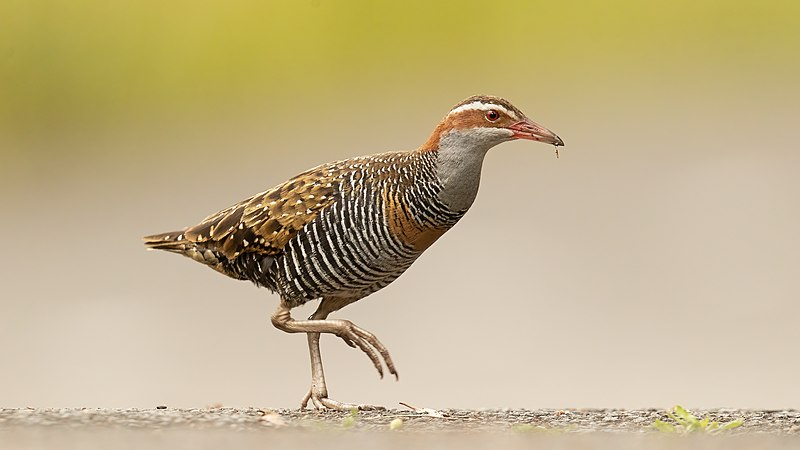
The Buff-banded Rail is a beautiful bird found across Australasia and the South West Pacific. It has distinctive black, brown, white and buff plumage which makes it easily recognizable.
Its long legs are adapted for wading in shallow water where it feeds on small fish, crustaceans, insects and vegetable matter.
This species is highly dispersive with some subspecies being found as far away as the Philippines (where they are known as Tikling) or New Zealand (known there as Moho-p).
With its adaptability to various habitats such as mangroves swamps, saltmarshes and farmlands; this species can be seen running around during low tide looking for food or hiding among vegetation when alarmed by potential danger.Scientific classification:
| Kingdom | Animalia |
| Phylum | Chordata |
| Class | Aves |
| Order | Gruiformes |
| Family | Rallidae |
| Genus | Hypotaenidia |
| Species | H. philippensis |
Also Featured In: Birds that Live around Brisbane, Water Birds Live around Us
17. Brown Quail
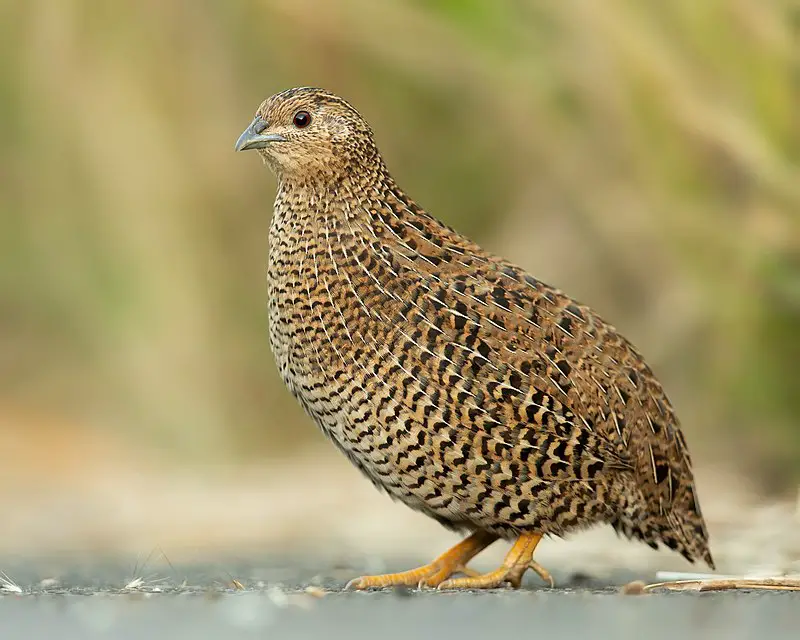
The Brown Quail is a true quail of the Phasianidae family found in Australia, Tasmania, Papua New Guinea and other parts of the Pacific. It’s small size and ground-dwelling habits make it quite common in its range.
The bird has brown feathers on its upper body with black stripes running down either side, while its underside is white or pale yellow.
Its diet consists mainly of grass seeds and insects as well as leaves from various plants.
These birds are usually seen foraging around dawn or dusk when they search actively for food but can also be observed at night using their sharp hearing to detect predators nearby.
Overall this pretty little bird makes an interesting addition to any garden.Scientific classification:
| Kingdom | Animalia |
| Phylum | Chordata |
| Class | Aves |
| Order | Galliformes |
| Family | Phasianidae |
| Genus | Synoicus |
| Species | S. ypsilophorus |
Also Featured In: New South Wales Birds You Need to See, Common Flinders Island Birds
18. Banded Fruit Dove
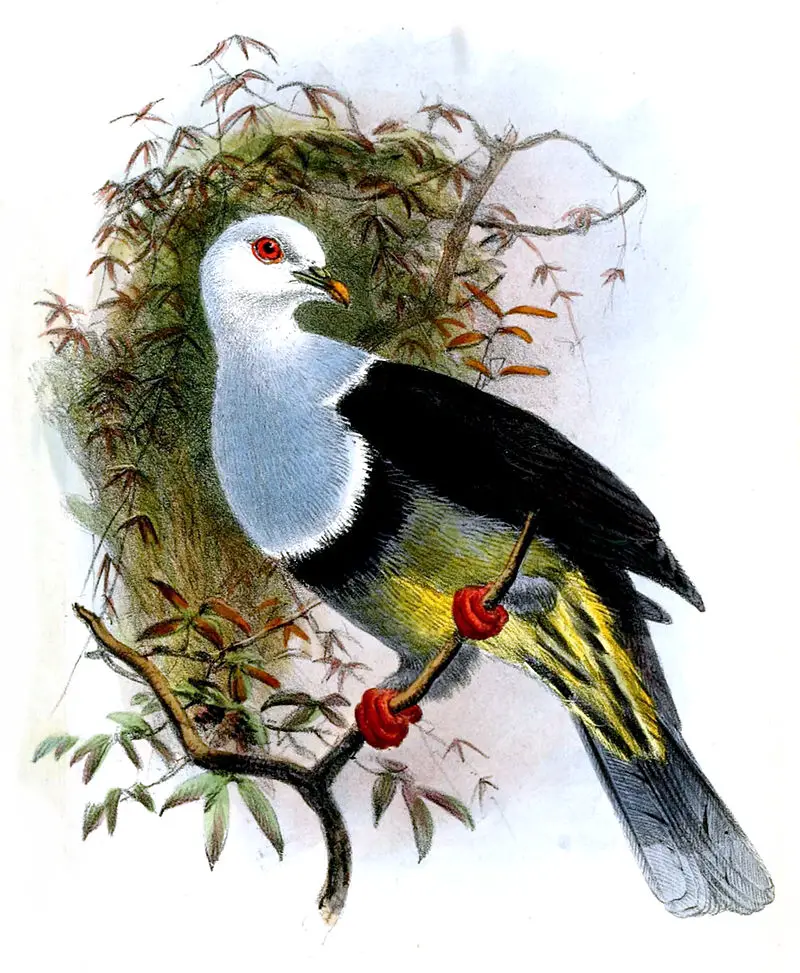
The Banded Fruit Dove is a stunning bird native to the Bali and Lesser Sunda Islands. It has an impressive wingspan of 38-44 cm, with a weight ranging from 450-570 g.
Its head, neck and upper breast are white while its back and upperwing have black colouring which gradually fades into grey on its rump.
The tail is all black but features a broad grey terminal band for contrast, whilst the underparts are also grey in colouration.
This species inhabits monsoonal forests where it can be seen searching for fruit amongst the foliage or perched high up in trees singing their beautiful song during mating season.
They may appear quite solitary however they usually live together as pairs or small groups depending on availability of food sources such as figs and other fruits found within their natural habitat range.Scientific classification:
| Kingdom | Animalia |
| Phylum | Chordata |
| Class | Aves |
| Order | Columbiformes |
| Family | Columbidae |
| Genus | Ptilinopus |
| Species | P. cinctus |
Also Featured In: Birds that Found in Kakadu National Park, Birds that Commonly Found in Bali
19. Pheasant Coucal
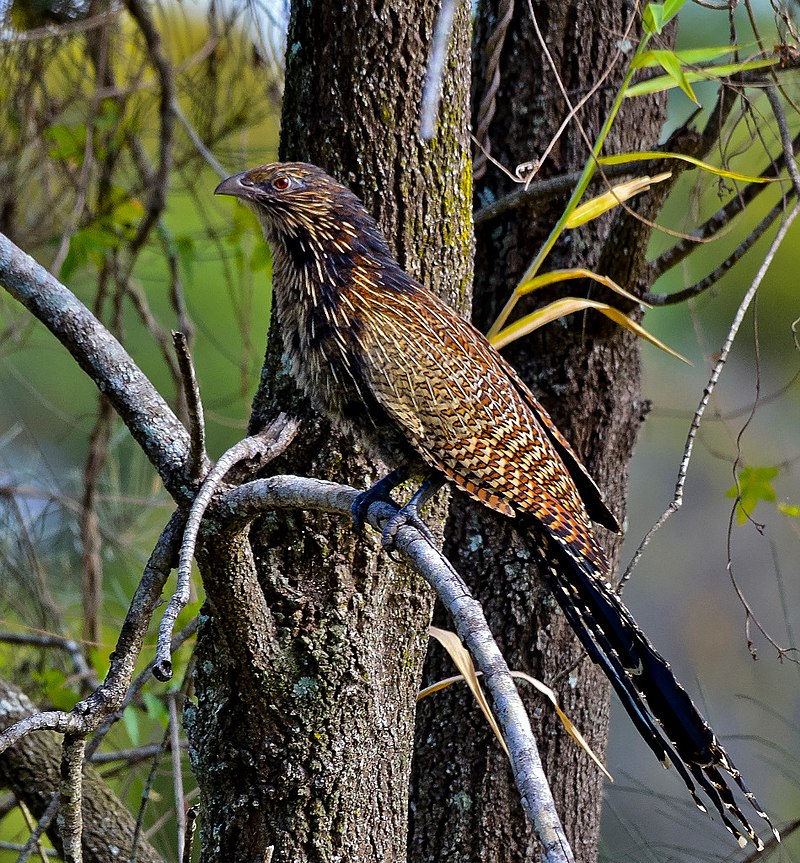
The Pheasant Coucal is a species of cuckoo native to Australia, Timor and New Guinea.
It can be found in subtropical or tropical moist lowland forests as well as mangrove forests but has also adapted well to agricultural areas such as cane fields in Northern Australia.
This makes it an unusual bird among the Australian cuckoos since unlike most other birds from this family, it doesn’t rely on its hosts for incubation and raising offsprings – instead, it does all that by itself.
The female typically lays three eggs which are oval-shaped with light blue colouring that fades over time.
Pheasant coucals have dark brown feathers with some lighter markings around their necks and wings making them look quite unique compared to other birds within the same family.Scientific classification:
| Kingdom | Animalia |
| Phylum | Chordata |
| Class | Aves |
| Order | Cuculiformes |
| Family | Cuculidae |
| Genus | Centropus |
| Species | C. phasianinus |
20. Horsfield’s Bronze Cuckoo
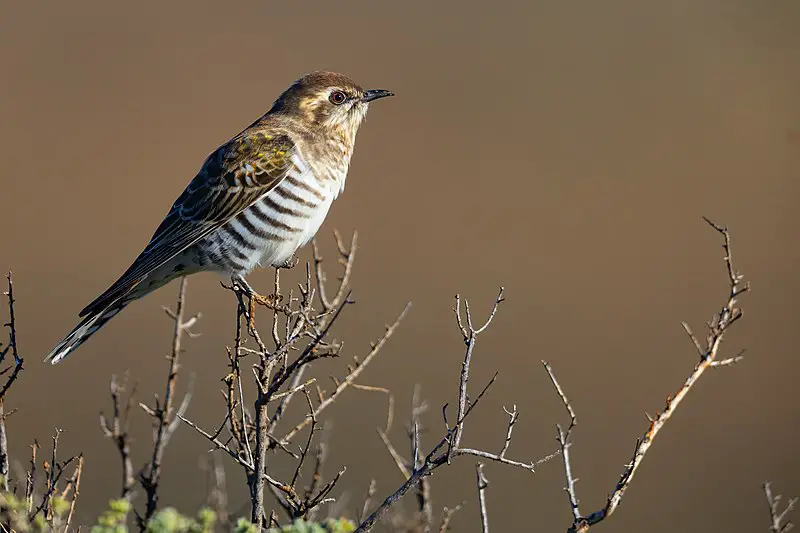
Horsfield’s bronze cuckoo is a small bird that belongs to the Cuculidae family. It has an average size of 22g and its most distinctive feature is its green and bronzed iridescent colouring on its back, as well as incomplete brown barring from neck to tail.
Other features include a white eyebrow and brown eye stripe which help distinguish this species from other bronze cuckoos.
This bird can be found in many areas including Australia, New Guinea, Indonesia, East Timor and some parts of South-east Asia where it feeds mainly on insects like caterpillars or beetles.
Horsfield’s Bronze Cuckoo also enjoys eating fruit such as figs when they are available in abundance during fruiting season.Scientific classification:
| Kingdom | Animalia |
| Phylum | Chordata |
| Class | Aves |
| Order | Cuculiformes |
| Family | Cuculidae |
| Genus | Chrysococcyx |
| Species | C. basalis |
21. White-Browed Crake
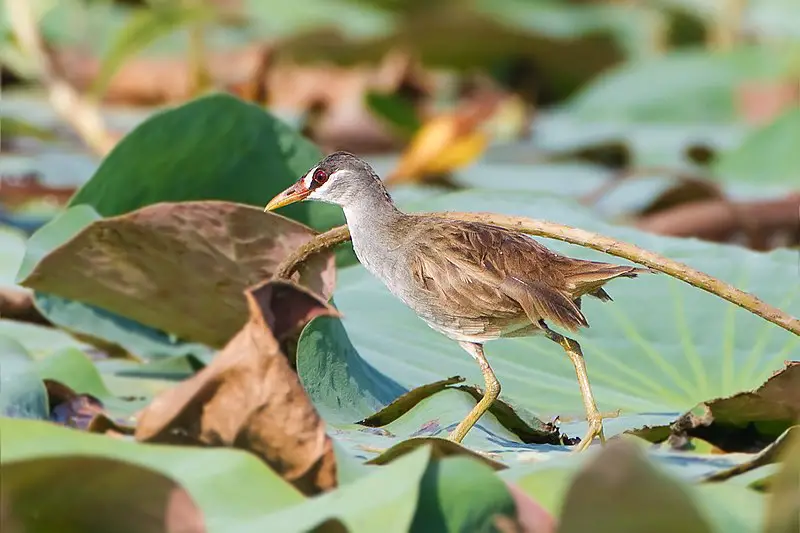
The White-browed Crake is an amazing bird found in many different parts of the world such as Australia, Brunei and even Japan.
It lives mostly in subtropical or tropical mangrove forests, where it can find plenty of food to survive on.
This species has a white head with brown eyes, combined with its slate grey back gives it a unique look that makes them stand out from other birds.
Its diet consists mainly of small invertebrates like insects and larvae but they also feed on fruits when available.
They are shy by nature so if you spot one be sure not to scare it away. Despite their rarity they have been known to breed successfully in captivity and thus have had some success at conservation efforts aimed at preserving this beautiful species.Scientific classification:
| Kingdom | Animalia |
| Phylum | Chordata |
| Class | Aves |
| Order | Gruiformes |
| Family | Rallidae |
| Genus | Poliolimnas Sharpe, 1893 |
| Species | P. cinereus |
Also Featured In: Samar Island Birds You Should Know,
22. Oriental Cuckoo
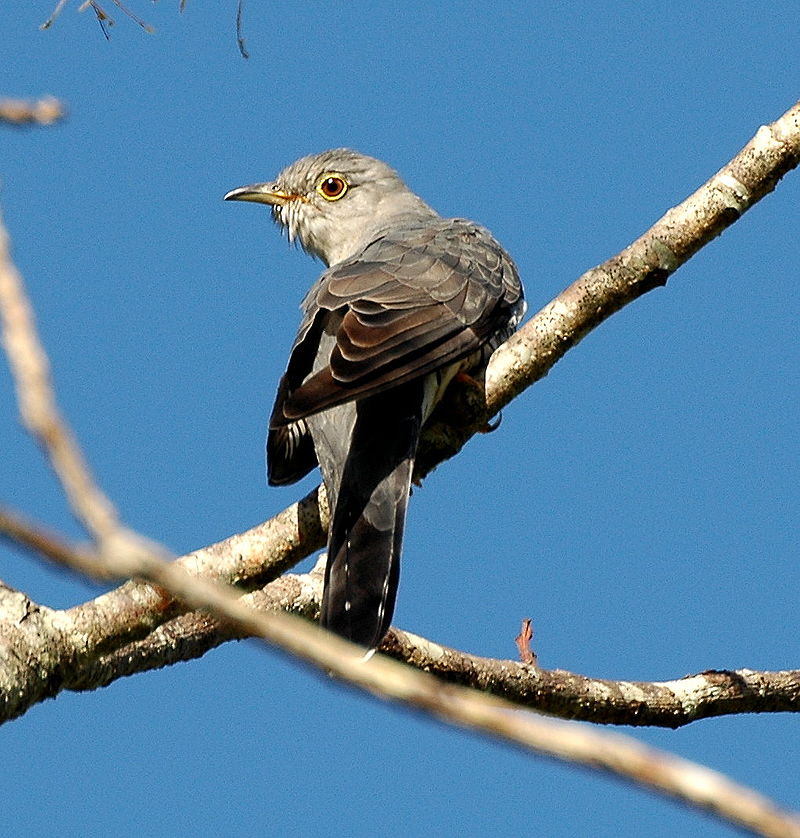
The Oriental Cuckoo, also known as Horsfields cuckoo, is a species of bird in the family Cuculidae. It was formerly classified as a subspecies of Himalayan cuckoo but its differences in voice and size made it worthy to be treated separately.
This medium-sized songbird has brown upperparts with white spots and rufous underparts with dark barring.
The wings are barred blackish-brown on their outer webs while the tail feathers have broad bars at their tips forming two white bands across them.
Although they breed mainly where conifers grow, these birds can often be seen flitting through deciduous forest edges or woodlands during migration season when they fly south from northern Asia to spend winter in Southeast Asia.
They feed mostly on caterpillars and other insects which makes them important pest controllers for our environment.Scientific classification:
| Kingdom | Animalia |
| Phylum | Chordata |
| Class | Aves |
| Order | Cuculiformes |
| Family | Cuculidae |
| Genus | Cuculus |
| Species | C. optatus |
Also Featured In: Birds that Live in Sunshine Coast, Birds Commonly Found in Kyoto
23. Sunda Cuckoo
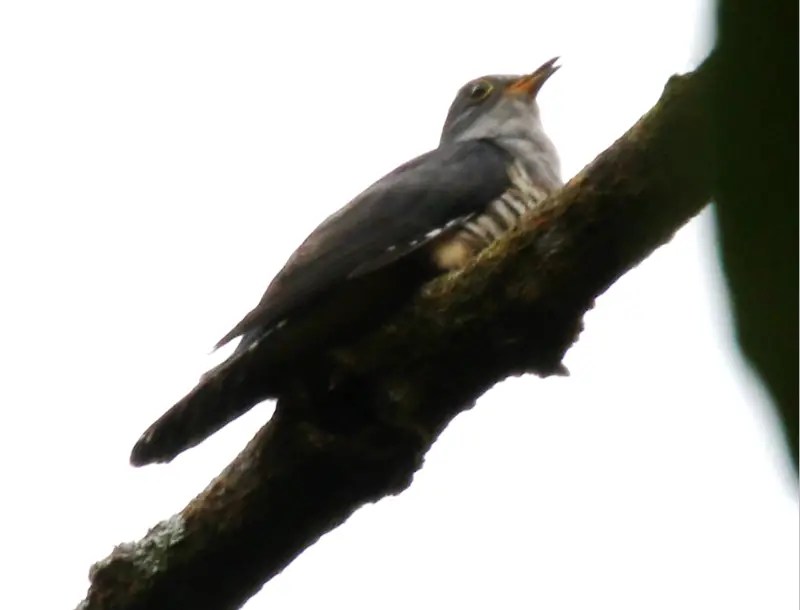
The Sunda cuckoo or Sunda lesser cuckoo is a South-east Asian bird belonging to the Cuculidae family. It was formerly classified with two other species, but has since been regarded as separate due to differences in voice, size and plumage.
The bird measures around 29–30 cm long, boasting grey upperparts and white underparts which are barred black on its chest and flanks.
Its wingspan ranges from 45 to 50 cm wide while its tail length can reach up to 17cm long.
This medium sized avian also features yellow eyes along with a red bill that curves downwards at the tip.
As an insectivore this species primarily feeds on insects such as beetles, crickets and grasshoppers found in open habitats including woods edges near streams or rivers during the day time hours of sunlight – they hunt by perching themselves atop branches then swooping down for their prey below them.Scientific classification:
| Kingdom | Animalia |
| Phylum | Chordata |
| Class | Aves |
| Order | Cuculiformes |
| Family | Cuculidae |
| Genus | Cuculus |
| Species | C. lepidus |
24. Yellow-Crested Cockatoo
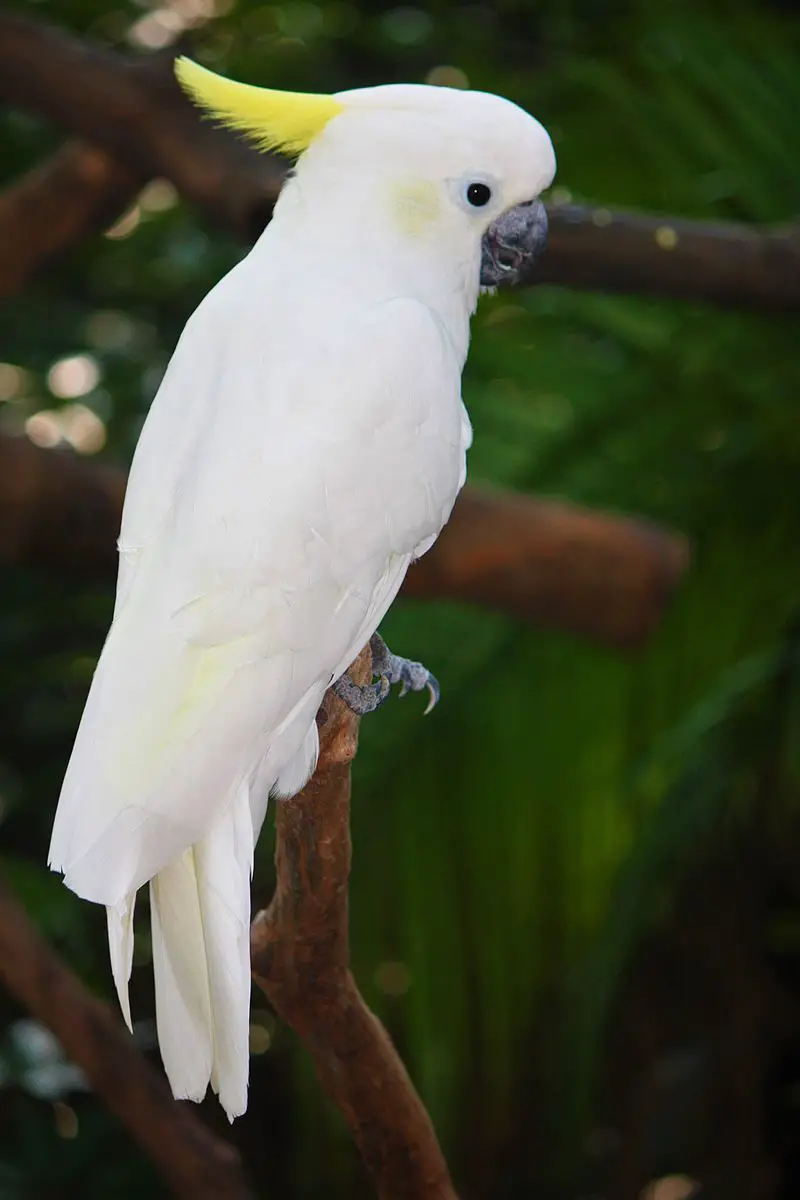
The Yellow-crested Cockatoo is a beautiful and striking bird that can be found in East Timor and the Sula Islands of Indonesia.
It has white plumage, bluish-white bare orbital skin, grey feet, a black bill and an impressive retractile yellow or orange crest.
These birds stand at around 34 cm long which makes them medium sized amongst cockatoos.
They prefer to live in wooded areas as well as cultivated land but are unfortunately endangered due to habitat loss from deforestation along with illegal trapping for pet trade purposes.
They have been listed under CITES Appendix I since 1981 meaning all activities involving international commercial trading of these birds must cease immediately if they are ever going to make a full recovery within their natural habitats again.Scientific classification:
| Kingdom | Animalia |
| Phylum | Chordata |
| Class | Aves |
| Order | Psittaciformes |
| Family | Cacatuidae |
| Genus | Cacatua |
| Subgenus | Cacatua |
| Species | C. sulphurea |
Also Featured In: Hong Kong Birds You Need to See, Big Birds that Live in Singapore
25. Thick-Billed Flowerpecker
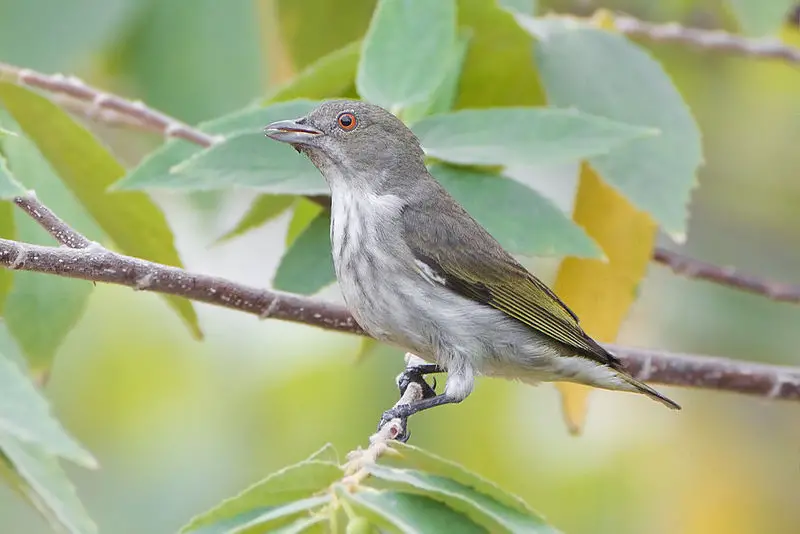
The Thick-billed Flowerpecker is a tiny bird that belongs to the flowerpecker group. It has a wide distribution across tropical southern Asia, ranging from India east to Indonesia and Timor.
They are active birds found in the tops of trees in forests and they predominantly feed on fruits.
This species is also considered as resident with several populations recognized as subspecies, some of which may be treated as their own separate species at times.
These little birds have bright plumage making them quite attractive while they search for food amongst tree canopies or fly around looking for insects or nectar sources.Scientific classification:
| Kingdom | Animalia |
| Phylum | Chordata |
| Class | Aves |
| Order | Passeriformes |
| Family | Dicaeidae |
| Genus | Dicaeum |
| Species | D. agile |
Also Featured In: Common Birds that Live in Odisha, Palawan Island Birds
26. Dusky Moorhen
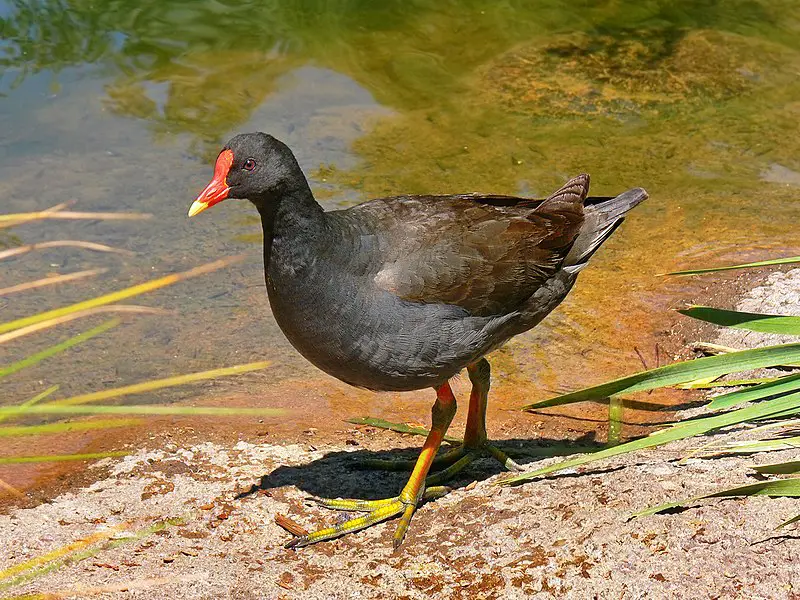
The dusky moorhen is a species of bird found in India, Australia, New Guinea, Borneo and Indonesia. It has dark plumage with an iridescent green sheen on its back and wings.
Its beak and legs are yellow-orange in color. The tail is long and pointed. Dusky moorhens live around freshwater wetlands such as swamps or ponds where they feed largely on aquatic vegetation but may also eat small insects or fish if available.
They often live alongside other birds from the same genus like purple swamphens or Eurasian coots which have similar appearances but different habitats preferences than their own species’.
Although timid when approached by humans these birds still make fascinating subjects for observation due to their unique behaviors within family groups that can help us understand more about them.Scientific classification:
| Kingdom | Animalia |
| Phylum | Chordata |
| Class | Aves |
| Order | Gruiformes |
| Family | Rallidae |
| Genus | Gallinula |
| Species | G. tenebrosa |
Also Featured In: Birds that Live Near Adelaide, Common Melbourne Birds
27. Tawny Grassbird
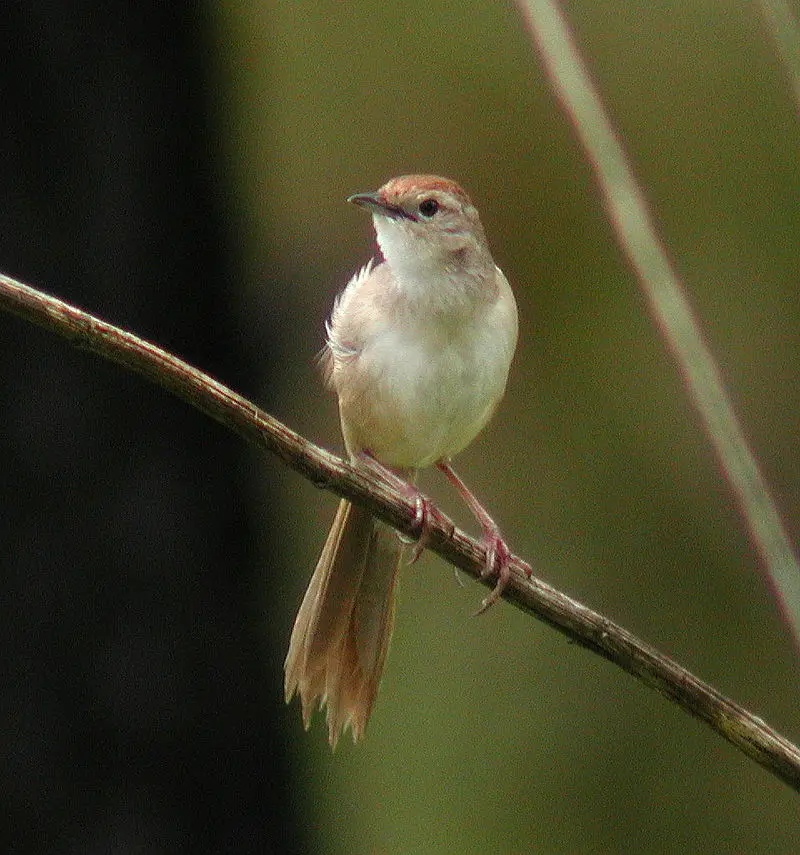
The tawny grassbird is a large songbird with an impressive brown cap and streaked upperparts. This bird belongs to the family of Locustellidae which live in grassland or reedbed habitats.
Its under parts are paler, while it has a long graduated tail. It also makes loud grumpy churring calls and longer ticking call that starts tick-tick-tick-tic.
They prefer open areas like wet meadows, marshlands or wetlands for their habitat as they feed on small insects from these area such as spiders, ants and beetles among others.
Their diet consist mainly of insects but some may supplement them with vegetable matter too during winter months when insect availability is low .
The tawny grassbirds usually breed between August to October each year depending upon the weather conditions..Scientific classification:
| Kingdom | Animalia |
| Phylum | Chordata |
| Class | Aves |
| Order | Passeriformes |
| Family | Locustellidae |
| Genus | Cincloramphus |
| Species | C. timoriensis |
Also Featured In: Most Common Birds in Negros, Mindoro Birds You Should Know
28. Short-Tailed Starling
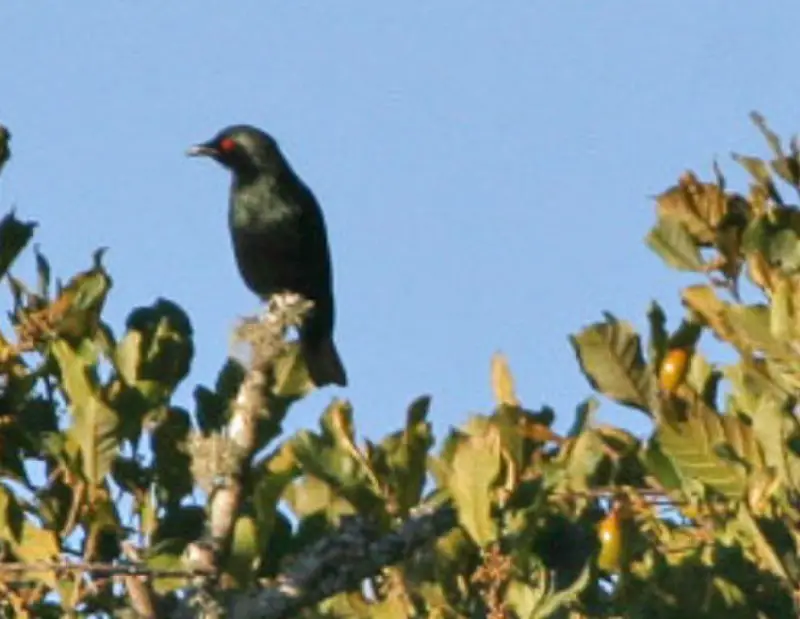
The Short-tailed starling is a species of bird from the Sturnidae family, found in Indonesia and the Philippines. It has black plumage with yellowish underparts, pink bill, and short tail feathers.
Its natural habitats are humid lowland forests and moist montane forests. These birds often form large flocks to feed on fruits scattered around their habitat or roost overnight at communal sites near trees or shrubs.
They also visit gardens for water baths during hot afternoons as well as take dustbaths which helps them keep parasites away from their body feathers while preening themselves afterwards.
In addition they have been known to raid crops such as rice fields if food resources become scarce due to human activities like deforestation or overhunting.Scientific classification:
| Kingdom | Animalia |
| Phylum | Chordata |
| Class | Aves |
| Order | Passeriformes |
| Family | Sturnidae |
| Genus | Aplonis |
| Species | A. minor |
29. Red-Backed Buttonquail
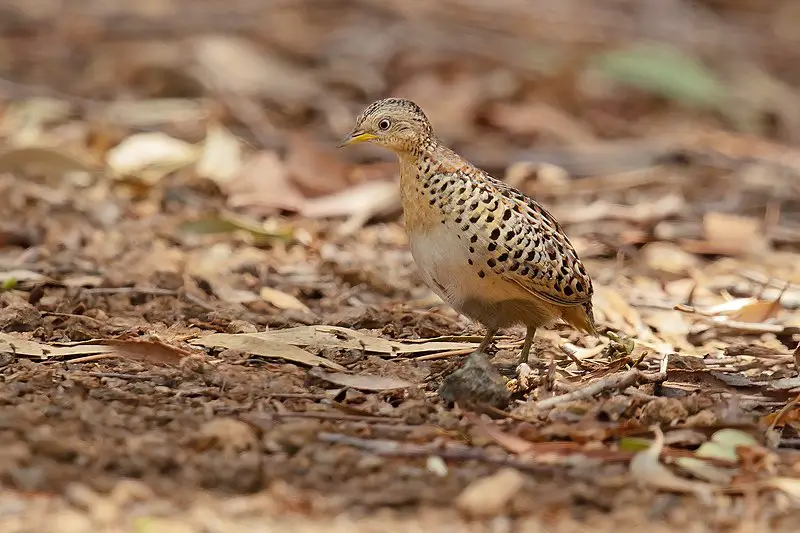
The red-backed buttonquail is a small ground bird found in Australia, Indonesia, Papua New Guinea, the Philippines and the Solomon Islands.
It has fourteen recognised subspecies and can be known by names such as black-backed or orange-breasted buttonquail.
These birds are usually seen alone or in pairs but never more than four together at any one time. With its distinctive mottled brown feathers it blends into its environment seamlessly so that they may be hard to spot even when close up.
The diet of this species consists mainly of seeds which they scratch from the soil using their feet; however insects make up an important part of their diet too.
They live mostly on open grasslands with scattered shrubs for cover where there is plenty of food available throughout the year making them well suited to living in these areasScientific classification:
| Kingdom | Animalia |
| Phylum | Chordata |
| Class | Aves |
| Order | Charadriiformes |
| Family | Turnicidae |
| Genus | Turnix |
| Species | T. maculosus |
Also Featured In: Birds that Charles Darwin Studied,
30. Plain Gerygone
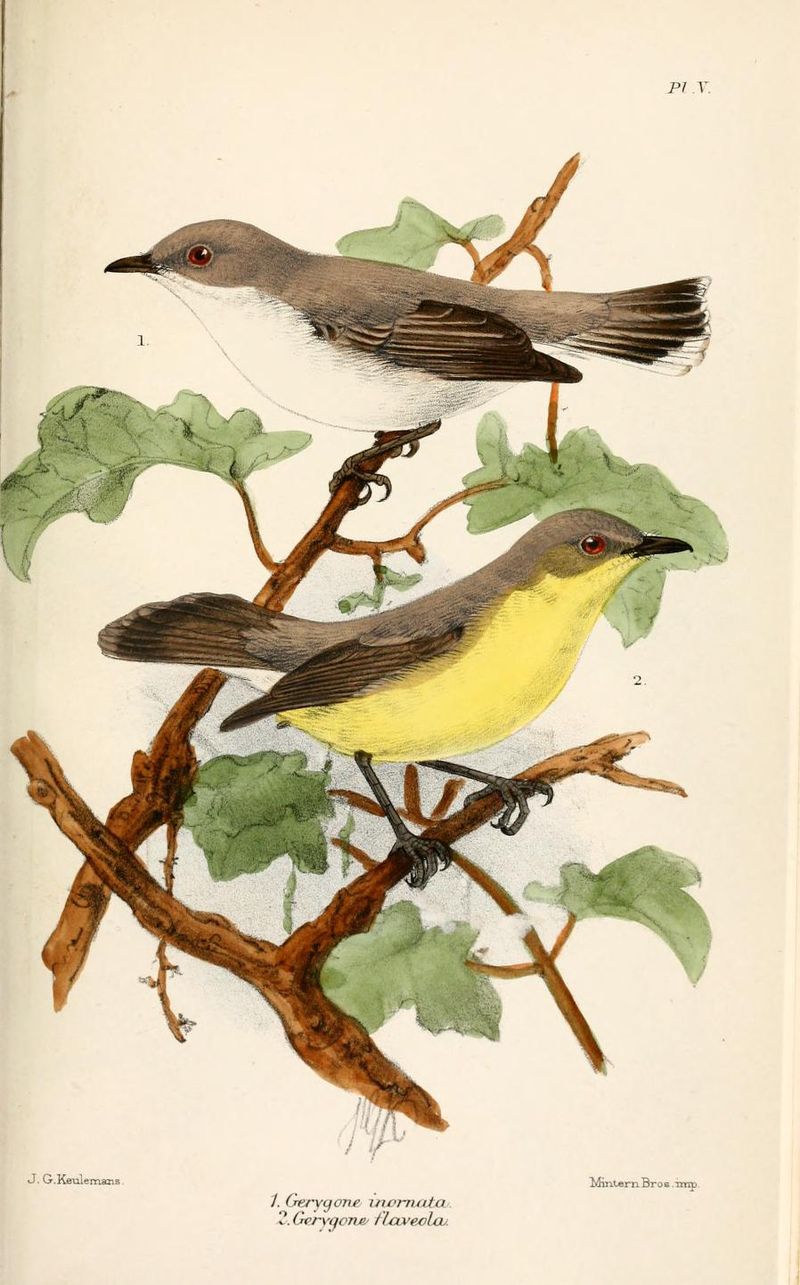
The Plain gerygone is a species of bird found in the family Acanthizidae. It lives on the islands of Wetar and Timor, inhabiting both subtropical lowland forests and mangrove forests.
This small gray-brown songbird has no distinct markings, but it does have bright yellow eyes that contrast with its otherwise plain appearance.
The Plain Gerygone feeds mostly on insects like flies, spiders and moths which it catches off leaves or even midair.
Its call is a gentle chattering sound reminiscent of other members of its family such as thornbills or scrubwrens.
Although not threatened overall, human activity continues to threaten their habitats so conservation efforts should be taken to preserve them for future generations to appreciate this little bird’s beauty and unique songs.Scientific classification:
| Kingdom | Animalia |
| Phylum | Chordata |
| Class | Aves |
| Order | Passeriformes |
| Family | Acanthizidae |
| Genus | Gerygone |
| Species | G. inornata |
31. Streak-Breasted Honeyeater
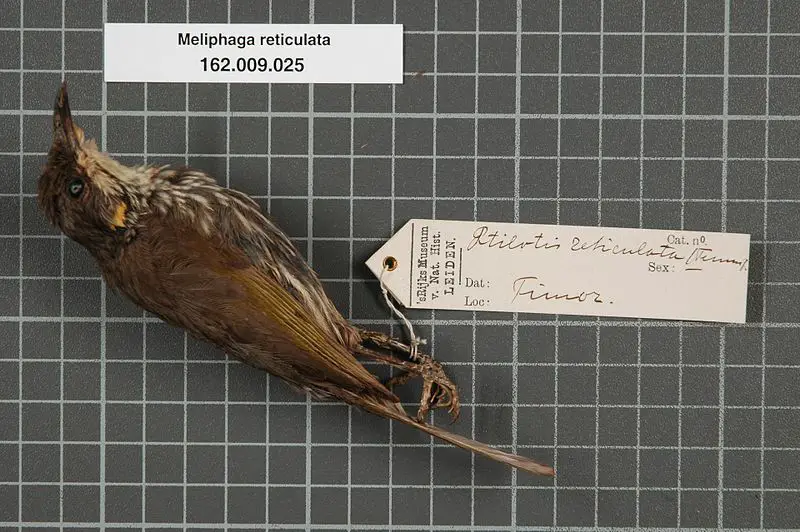
The Streak-breasted honeyeater is a beautiful species of bird found exclusively on the island of Timor.
With its distinctive, light brown feathers streaked with darker markings along the breast and wings, it stands out in any environment.
This small bird typically lives in subtropical or tropical lowland forests as well as mangrove forests and montane woodlands.
It is an omnivore that feeds mainly on insects but also enjoys nectar from flowers for extra energy throughout the day.
The Streak-breasted honeyeater plays an important role in pollination thanks to their habit of eating pollen while searching for food and spreading it among different plants when they move around looking for more sustenance.
These birds are considered vulnerable due to habitat loss caused by logging activities so conservation efforts should be made to protect them and their natural home.Scientific classification:
| Kingdom | Animalia |
| Phylum | Chordata |
| Class | Aves |
| Order | Passeriformes |
| Family | Meliphagidae |
| Genus | Territornis |
| Species | T. reticulata |
32. Island Monarch
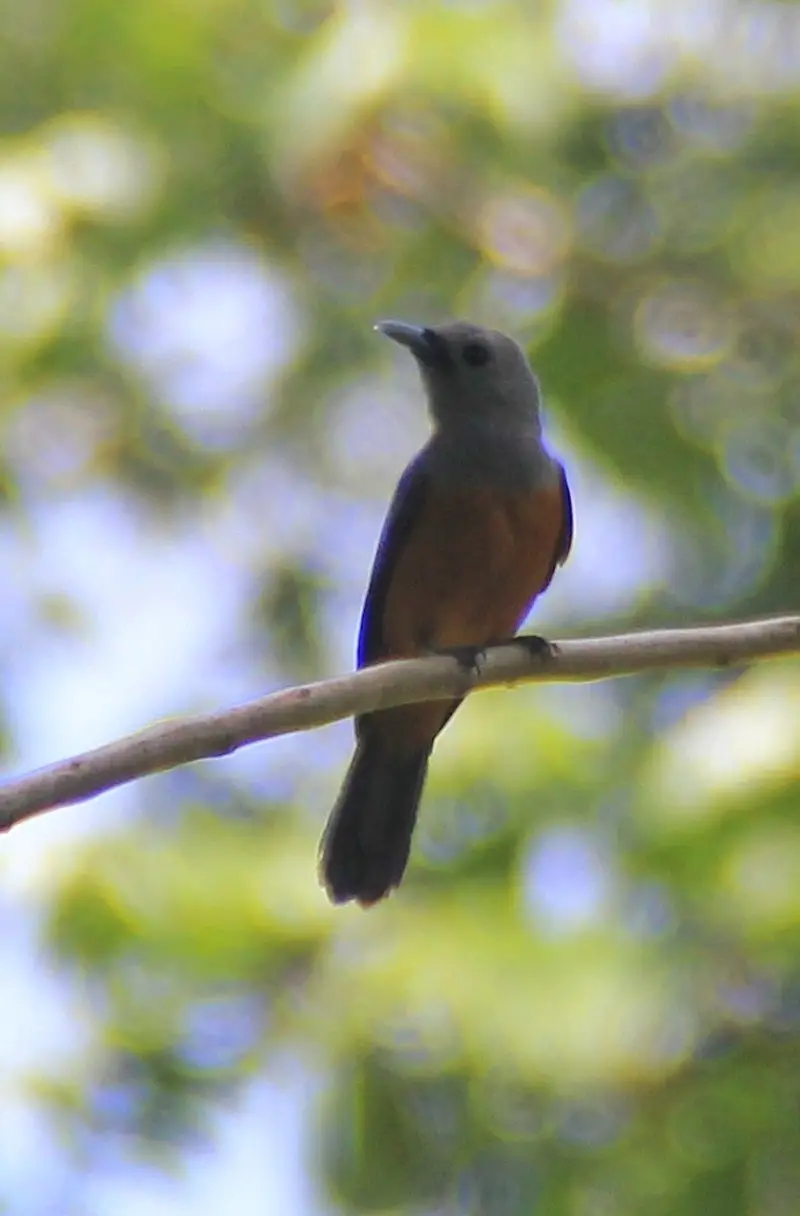
The Island Monarch is a species of bird from the family Monarchidae, found in regions ranging from Sulawesi to the Solomon Islands. They inhabit subtropical or tropical moist lowland forests and montane forests.
The Island monarch was initially classified as Drymophila but has since been given its own genus – Monarcha cinerascens.
It also goes by other names such as Grey-headed monarch and island grey-headd monarch.
They are small birds with a total length of up to 17 centimeters long, have dark brown eyes distinctive white eye rings, dull olive green upperparts that contrast their yellow underparts on both males and females alike.
They differ only slightly in colour between sexes where males tend to be brighter than females due to sexual dimorphism.
They mostly feed on insects which can be caught while flying through trees or shrubs near forest edges within their habitat rangeScientific classification:
| Kingdom | Animalia |
| Phylum | Chordata |
| Class | Aves |
| Order | Passeriformes |
| Family | Monarchidae |
| Genus | Monarcha |
| Species | M. cinerascens |
33. Flame-Breasted Sunbird
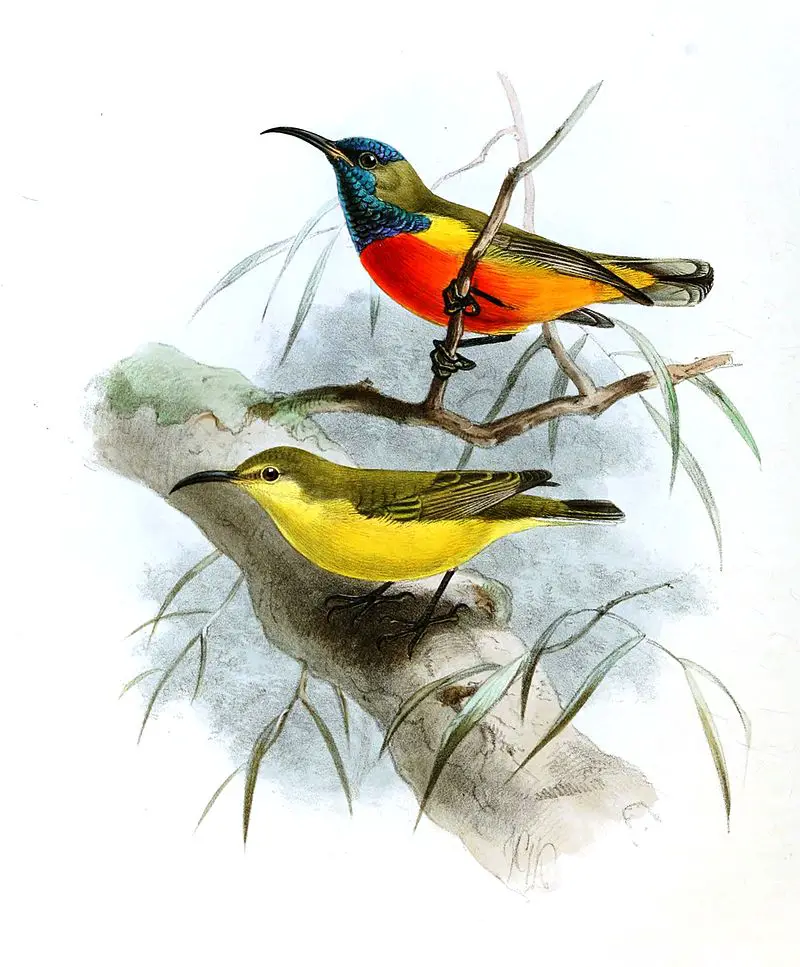
The Flame-breasted sunbird is a small species of bird belonging to the Nectariniidae family, mainly found in Indonesia’s province of Nusa Tenggara Timur.
They inhabit subtropical or tropical forests and are known for their vibrant colouring; with bright orange feathers on their chest, contrasted by black wings and head.
In addition to this they have yellow underside feathers which can be seen when they fly.
Sunbirds feed on nectar from flowers due to having long curved bills suited adapting them perfectly for extracting nectar from deep within flower buds.
When they aren’t feeding however, these birds will often engage in hopping around branches as well singing melodious tunes like many smaller birds do.
All together, The Flame-breasted Sunbird makes an excellent addition any forest ecosystem thanks its beautiful plumage and wonderful songs it produces.Scientific classification:
| Kingdom | Animalia |
| Phylum | Chordata |
| Class | Aves |
| Order | Passeriformes |
| Family | Nectariniidae |
| Genus | Cinnyris |
| Species | C. solaris |
34. Timor Oriole
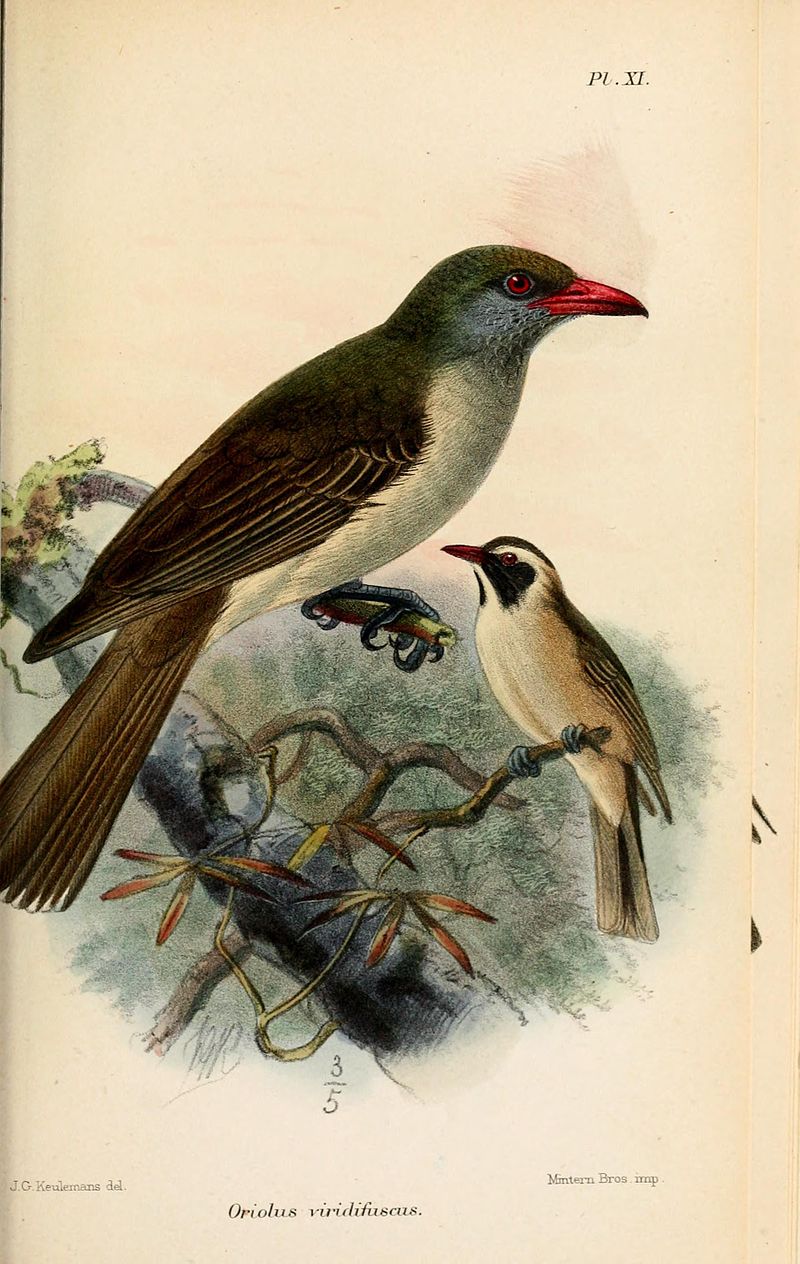
The Timor oriole is a species of bird that belongs to the family Oriolidae and is endemic to the Lesser Sundas.
It can be found on Timor, Rote and Semau Islands where its natural habitats are subtropical or tropical dry forests as well as subtropical or tropical mangrove forests.
This brightly colored bird has a striking black head with yellow shoulders, back and rump while its wings have white bars running through them.
Its underparts are mainly yellow apart from some orange feathers near its tail tip which enhances their beauty even further.
The Wetar oriole was originally thought to be separate but recent studies suggest they may in fact belong to the same species due to similarities between them both morphologically and genetically.Scientific classification:
| Kingdom | Animalia |
| Phylum | Chordata |
| Class | Aves |
| Order | Passeriformes |
| Family | Oriolidae |
| Genus | Oriolus |
| Species | O. melanotis |
35. Spotless Crake
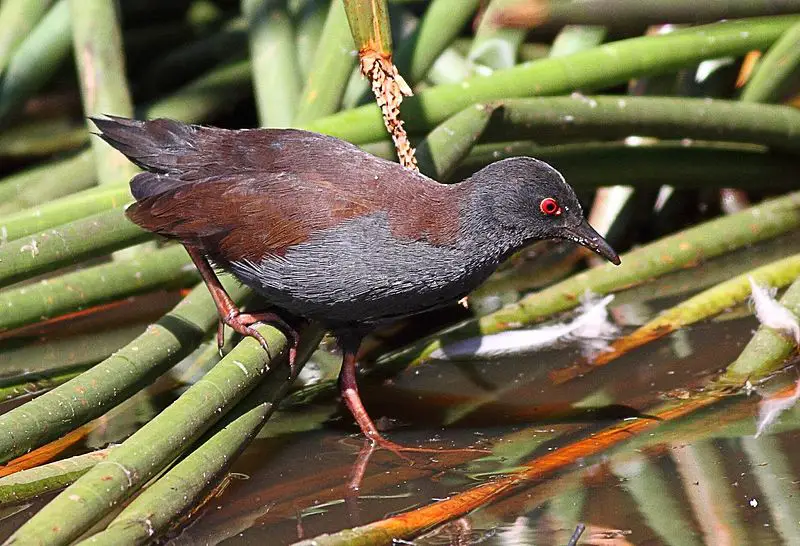
The Spotless Crake is a species of bird belonging to the rail family, Rallidae. It has an extensive range spanning across the Philippines, New Guinea and Australia as well as into the southern Pacific Ocean reaching all way down to Marquesas Islands and even New Zealand.
The German naturalist Johann Friedrich Gmelin described it in 1789 when he revised his edition of Systema Naturae which was established by Carolus Linnaeus earlier on.
This fascinating bird inhabits tropical swamps and other low-lying wetlands where there’s plenty of cover from vegetation such as reeds or grasses for them to hide away in.
Despite its name “spotless” crake, this species does actually have some unique markings that are used for identification purposes – brownish feathers with grey edging along its backside plus black stripes around its head/neck area too.Scientific classification:
| Kingdom | Animalia |
| Phylum | Chordata |
| Class | Aves |
| Order | Gruiformes |
| Family | Rallidae |
| Genus | Zapornia |
| Species | Z. tabuensis |
36. Jonquil Parrot
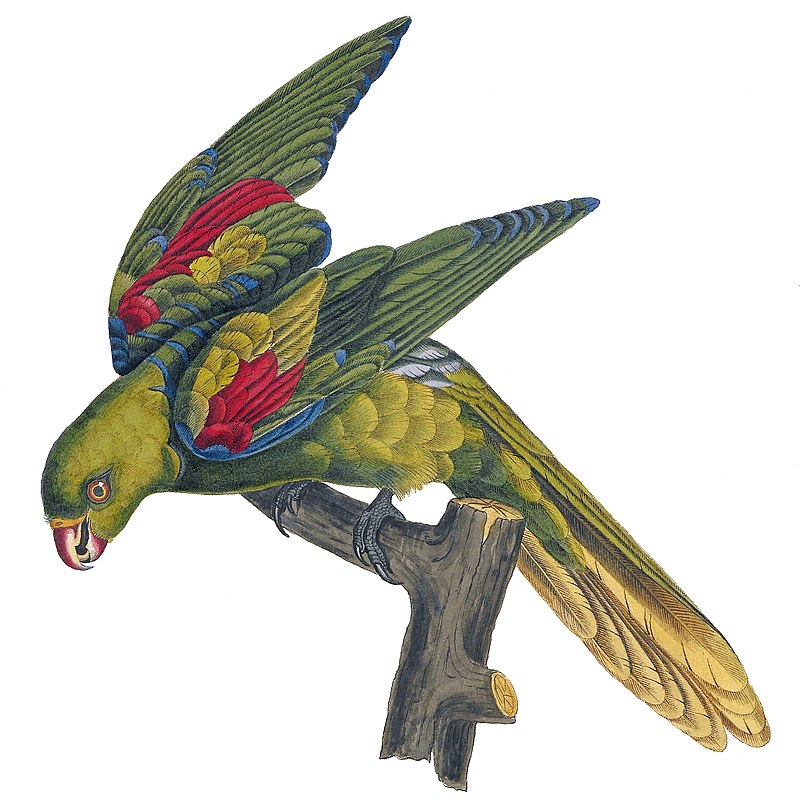
The Jonquil Parrot is a species of parrot found in the family Psittaculidae. It inhabits forest, woodland and acacia savanna on islands such as Roti, Timor and Wetar.
This bird has both sexes that look like females of closely related red-winged parrots.
Despite being fairly common, this species could be threatened by habitat loss due to human activities such as deforestation or agricultural expansion.
The most striking features are its olive shoulders with yellowish underparts along with a white-tipped tail feathers which catches attention when it flies away from danger.Scientific classification:
| Kingdom | Animalia |
| Phylum | Chordata |
| Class | Aves |
| Order | Psittaciformes |
| Family | Psittaculidae |
| Genus | Aprosmictus |
| Species | A. jonquillaceus |
37. Slaty-Breasted Rail
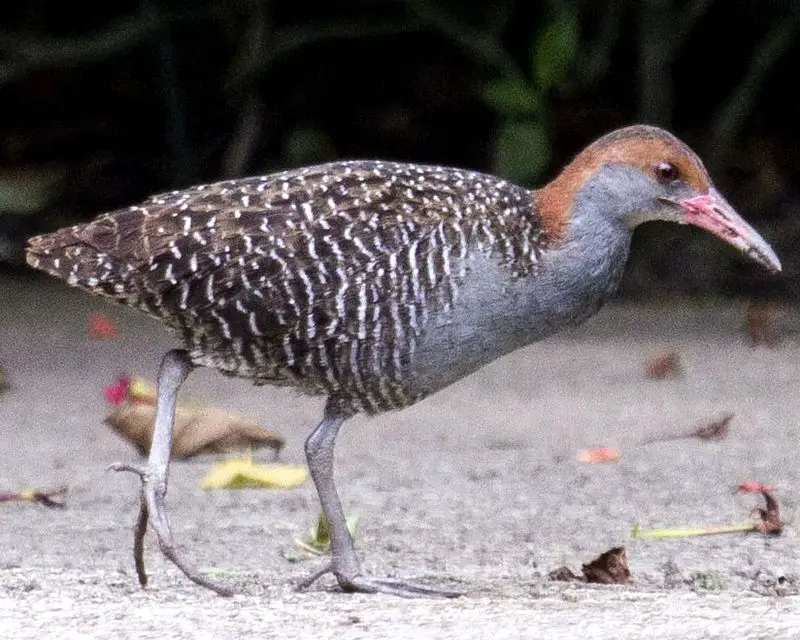
The Slaty-breasted Rail is a bird native to the Indian Subcontinent and Southeast Asia. During breeding season, they can be found near Dehradun in the foothills of India’s Himalayas.
This species has been placed in its own genus Lewinia due to new genetic studies which have now been accepted by the IUCN.
The plumage of this rail consists mainly of slaty grey with some black barring on its wings and tail feathers as well as vibrant chestnut flanks and belly.
It prefers habitats such as wetlands, muddy tidal flats or open grasslands for foraging where it searches for worms, insects and crustaceans among vegetation or mudflats respectively.
Despite being uncommon throughout much of their range these birds are not yet considered threatened – though further research into population numbers is necessary before we can fully understand their conservation status today.Scientific classification:
| Kingdom | Animalia |
| Phylum | Chordata |
| Class | Aves |
| Order | Gruiformes |
| Family | Rallidae |
| Genus | Lewinia |
| Species | L. striata |
38. Shining Bronze Cuckoo
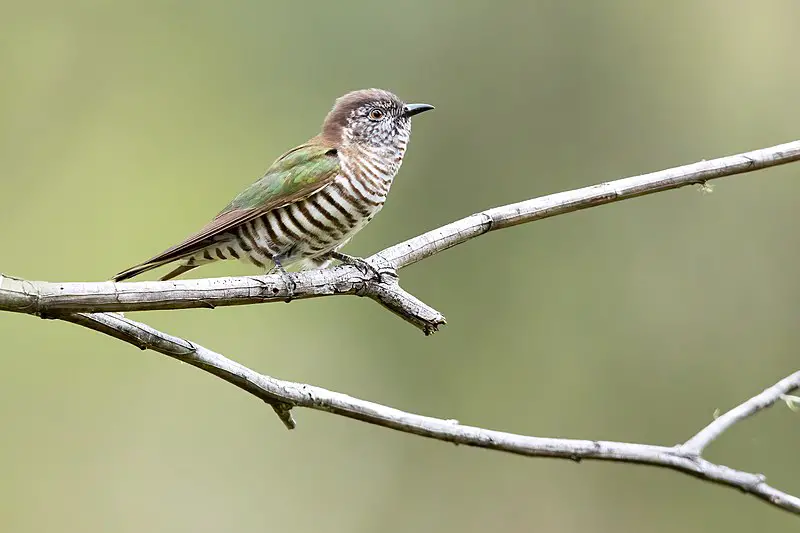
The Shining Bronze Cuckoo is a species of cuckoo found in many areas, including Australia, Indonesia and New Zealand.
It is quite small – only 13 to 18 cm long – but has beautiful plumage with glossy bronze-green on its upperparts and yellowish underparts.
This bird can be seen foraging in trees or shrubs for insects before returning back to its nest which it usually parasitises from other Gerygone species.
Its call consists of harsh croaks followed by an ascending whistle ‘kweeo’.
The diet primarily consists of beetles and caterpillars as well as fruits like figs depending on the season.
They are solitary birds that migrate over short distances during winter months while they largely remain sedentary throughout summer breeding periods when their numbers increase significantly due to nesting activity among tree branches near water sources such as rivers and swamps.Scientific classification:
| Kingdom | Animalia |
| Phylum | Chordata |
| Class | Aves |
| Order | Cuculiformes |
| Family | Cuculidae |
| Genus | Chrysococcyx |
| Species | C. lucidus |
Also Featured In: Most Common Western Australia Birds,
39. Sunda Collared Dove
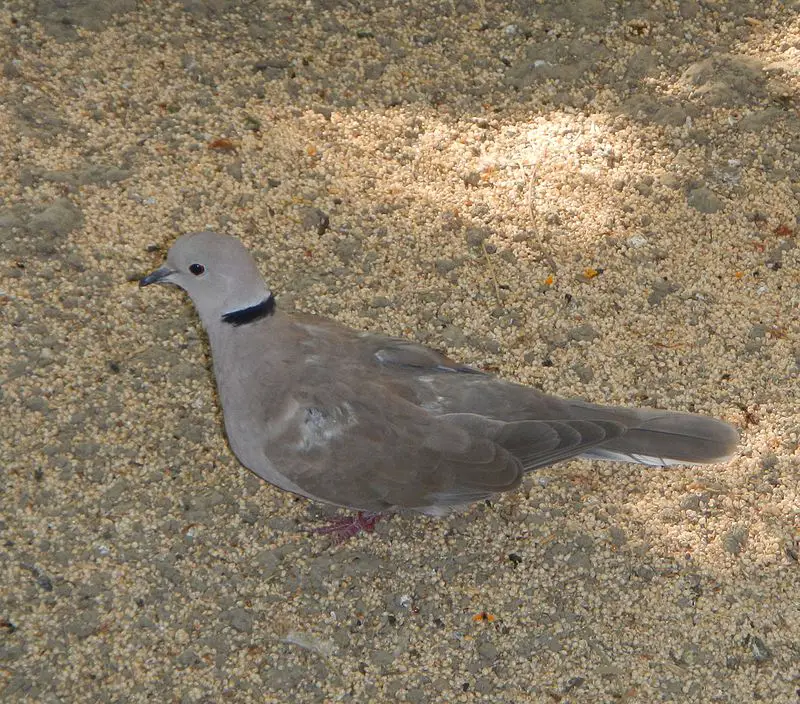
The Sunda collared dove is a beautiful species of bird found in the family Columbidae. It has an attractive gray-brown plumage with white patches on its neck and wings, giving it its “collared” name.
It can be found throughout tropical and subtropical islands from Indonesia to Myanmar. These birds are usually seen alone or in pairs as they feed on fruits, seeds and insects near cultivated areas such as farms, parks or gardens.
They make soft cooing sounds when disturbed but otherwise remain relatively quiet during their day-to-day activities.
The Sunda collared dove is a medium sized bird that grows up to 18 cm in length with a wingspan of 25–30 cm; they have long tails which help them maneuver through narrow passages while flying between trees looking for food sources.Scientific classification:
| Kingdom | Animalia |
| Phylum | Chordata |
| Class | Aves |
| Order | Columbiformes |
| Family | Columbidae |
| Genus | Streptopelia |
| Species | S. bitorquata |
Also Featured In: Guam Birds You Need to See, Beautiful Birds Found in Coron Island
40. Himalayan Cuckoo
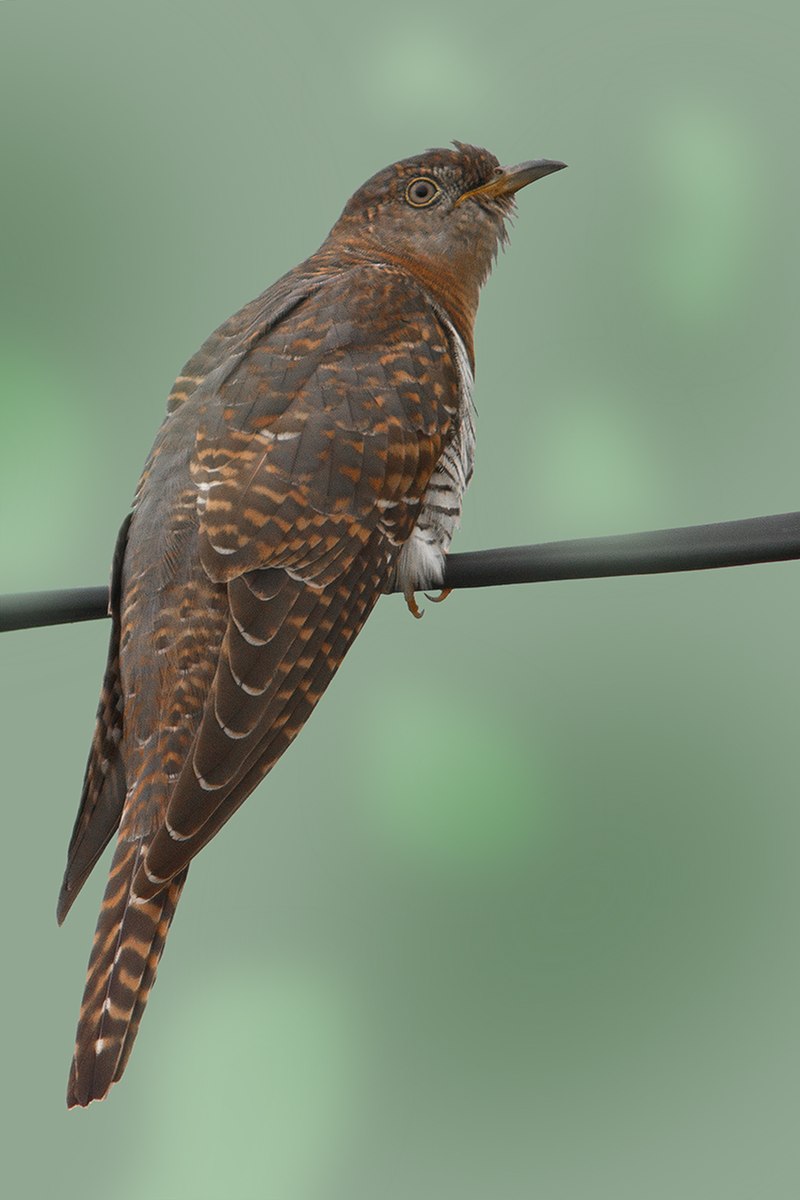
The Himalayan cuckoo is a species of bird found in the mountains of the Himalayas and parts of East Asia. It migrates south during winter to Southeast Asia, where it can be seen in greater numbers from October to March.
The distinctive call of this medium-sized greyish brown bird with white patches on its wings has become synonymous with the arrival of springtime for many people living around its range.
Its diet consists mainly insects picked up from foliage or snatched out of midair, as well as an occasional fruit or berry when available.
It lives mostly solitary life but forms pairs while breeding season which typically lasts between April and June depending upon location within its range.Scientific classification:
| Kingdom | Animalia |
| Phylum | Chordata |
| Class | Aves |
| Order | Cuculiformes |
| Family | Cuculidae |
| Genus | Cuculus |
| Species | C. saturatus |
41. Fawn-Breasted Whistler
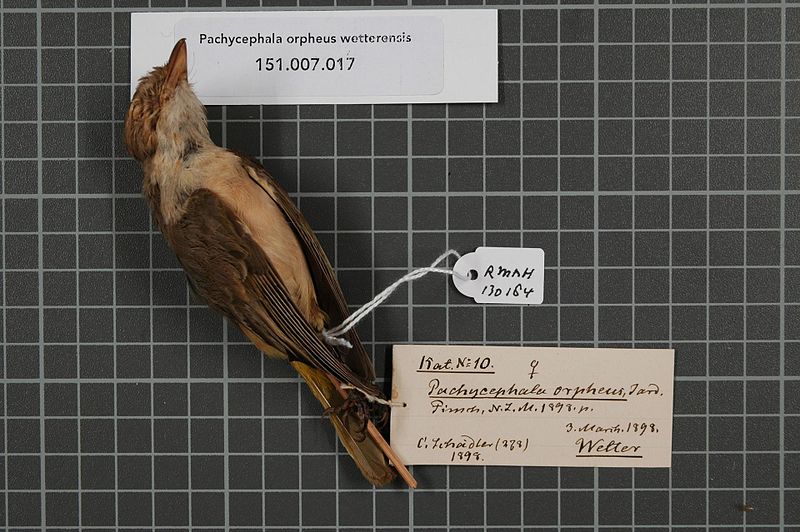
The Fawn-breasted Whistler is a species of bird found on the islands of Timor and Wetar. It is small in size, with predominantly fawn plumage and white underparts.
This beautiful little creature inhabits subtropical or tropical lowland forests as well as mangrove forests, where it feeds mainly on insects.
Its alternate names are Sunda whistler or Timor whistler due to its wide distribution across these two islands.
The male’s song consists of melodic trills which can be heard from far distances – hence the name ‘whistler’.
All in all, this tiny bird serves an important role within ecosystems by controlling insect populations while adding beauty to our natural world through its attractive features.Scientific classification:
| Kingdom | Animalia |
| Phylum | Chordata |
| Class | Aves |
| Order | Passeriformes |
| Family | Pachycephalidae |
| Genus | Pachycephala |
| Species | P. orpheus |
42. Aberrant Bush Warbler
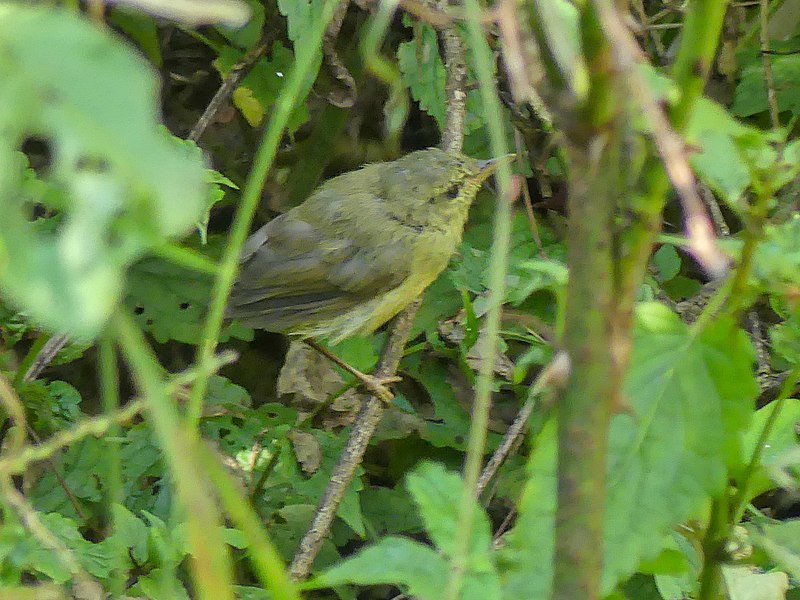
The Aberrant Bush Warbler is a species of bird found in Asia, primarily Central and Southern China. It belongs to the bush warbler family and was formerly part of the Old World warblers grouping.
This small songbird also inhabits northern Myanmar and Vietnam as well as countries such as Bhutan, India, Indonesia, Laos, Malaysia Nepal Philippines Thailand Timor-Leste and Vietnam.
Its diet consists mainly of insects which it finds on bark or foliage while foraging through trees or shrubs.
They have mostly brown plumage with greyish highlights but during breeding season males develop yellow patches around their throats making them easier to identify amongst other birds in its habitat.Scientific classification:
| Kingdom | Animalia |
| Phylum | Chordata |
| Class | Aves |
| Order | Passeriformes |
| Family | Cettiidae |
| Genus | Horornis |
| Species | H. flavolivaceus |
43. White-Bellied Bush Chat
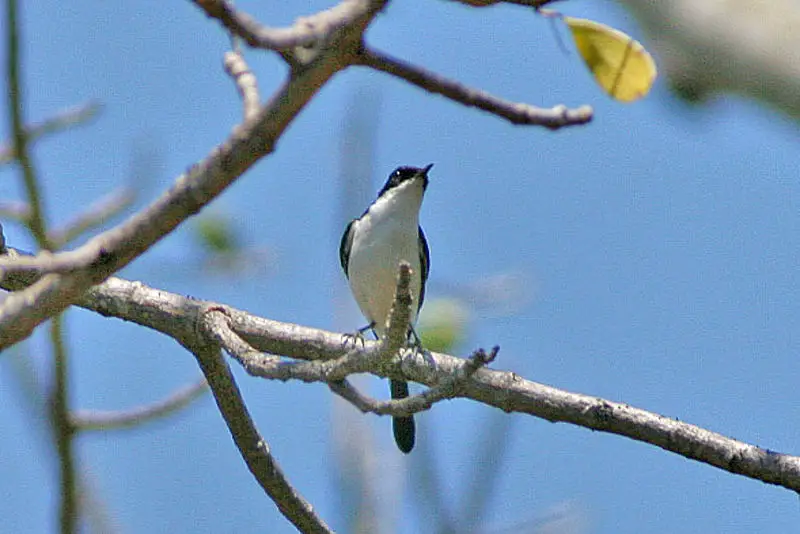
The White-bellied bush chat, a species of bird belonging to the family Muscicapidae, is found in Semau, Timor and Rote Island.
It inhabits subtropical or tropical moist lowland forests and dry savanna habitats; however, its population has been decreasing due to habitat loss from human activities such as deforestation.
This small passerine bird measures around 12 cm (5 inches) long and has greyish brown upperparts with whitish underparts which are faintly streaked on the breast.
Its head bears white superciliums while its throat is black with chestnut patch at sides along with a deeply forked tail that it flicks frequently when perching.
The diet of this particular species consists mainly of insects but they may also feed on some fruits occasionally too.Scientific classification:
| Kingdom | Animalia |
| Phylum | Chordata |
| Class | Aves |
| Order | Passeriformes |
| Family | Muscicapidae |
| Genus | Saxicola |
| Species | S. gutturalis |
44. Timor Cuckoo-Dove
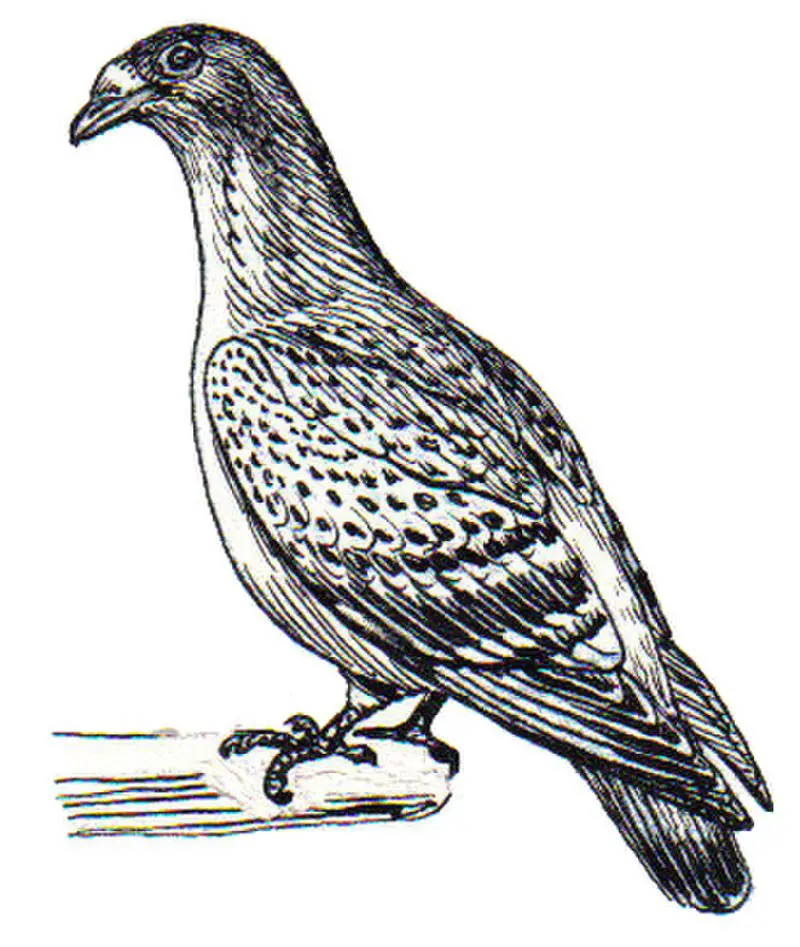
The Timor cuckoo-dove is a species of bird in the family Columbidae, found in Timor, Wetar and the eastern Lesser Sundas. It has dark grey plumage with an iridescent green neck patch, red eyes and orange legs.
The call is a low cooing sound repeated three times. Its diet consists mainly of fruits from trees such as figs and mangos which it finds by foraging among leaf litter on the ground or perching atop branches scanning for food below.
The IUCN Red List classifies this species as Least Concern due to its large range across multiple islands where it can be seen frequently perched near roads or open areas throughout most months of the year.Scientific classification:
| Kingdom | Animalia |
| Phylum | Chordata |
| Class | Aves |
| Order | Columbiformes |
| Family | Columbidae |
| Genus | Macropygia |
| Species | M. magna |
45. Timor Sparrow
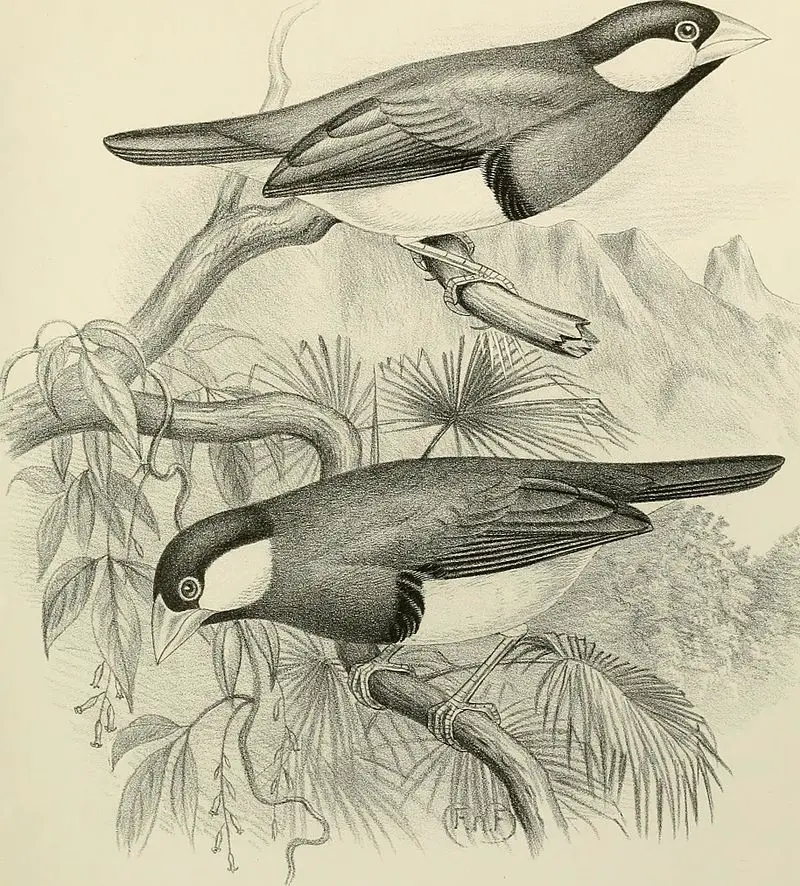
The Timor sparrow is a small bird that measures about 14 cm in length. It has dark brown plumage, with a large silvery-blue bill, white cheek and creamy-white belly.
Its feet are pink in colour and it resembles the closely related Java sparrow but is smaller in size.
This species inhabits grassy areas such as meadows, fields or open woodlands where they mainly feed on seeds of grasses and herbs.
They usually live together in flocks consisting of up to 50 individuals but also form pairs during breeding season when they build their nests among dense vegetation or even human structures like buildings or fences nearby water sources or other wetland habitats.
The Timor sparrow is an interesting species which needs protection from extinction due to its decreasing population numbers caused by habitat loss and degradationScientific classification:
| Kingdom | Animalia |
| Phylum | Chordata |
| Class | Aves |
| Order | Passeriformes |
| Family | Estrildidae |
| Genus | Padda |
| Species | P. fuscata |